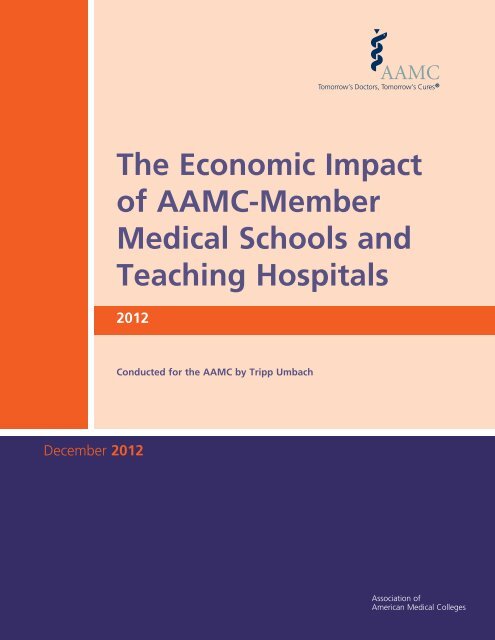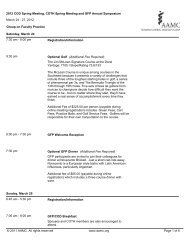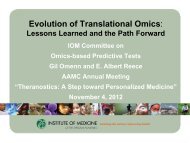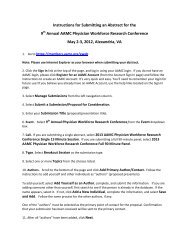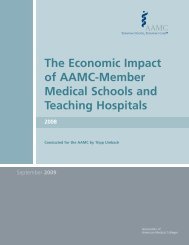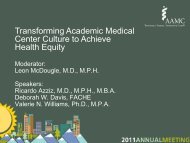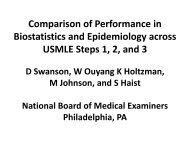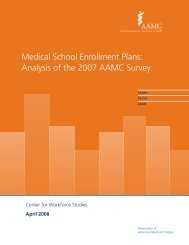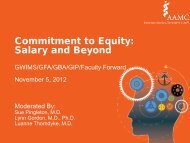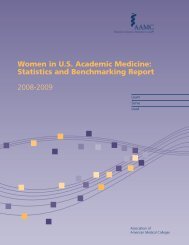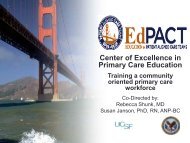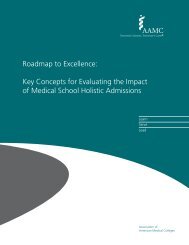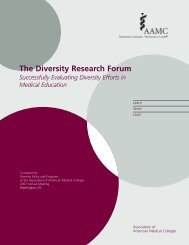The Economic Impact of AAMC-member Medical Schools - AAMC's ...
The Economic Impact of AAMC-member Medical Schools - AAMC's ...
The Economic Impact of AAMC-member Medical Schools - AAMC's ...
You also want an ePaper? Increase the reach of your titles
YUMPU automatically turns print PDFs into web optimized ePapers that Google loves.
<strong>The</strong> <strong>Economic</strong> <strong>Impact</strong><br />
<strong>of</strong> <strong>AAMC</strong>-Member<br />
<strong>Medical</strong> <strong>Schools</strong> and<br />
Teaching Hospitals<br />
2012<br />
Conducted for the <strong>AAMC</strong> by Tripp Umbach<br />
December 2012<br />
Association <strong>of</strong><br />
American <strong>Medical</strong> Colleges
For additional information about this publication, please contact:<br />
Jennifer Gold<br />
jgold@aamc.org<br />
Association <strong>of</strong> American <strong>Medical</strong> Colleges<br />
2450 N Street, NW<br />
Washington, DC 20037-1134<br />
©2012 Association <strong>of</strong> American <strong>Medical</strong> Colleges.<br />
This is a publication <strong>of</strong> the Association <strong>of</strong> American <strong>Medical</strong> Colleges. <strong>The</strong> <strong>AAMC</strong> serves and leads the<br />
academic medicine community to improve the health <strong>of</strong> all. www.aamc.org.
<strong>The</strong> <strong>Economic</strong> <strong>Impact</strong> <strong>of</strong> <strong>AAMC</strong>-Member<br />
<strong>Medical</strong> <strong>Schools</strong> and Teaching Hospitals<br />
2012<br />
Table <strong>of</strong> Contents<br />
Executive Summary 1<br />
Introduction 3<br />
Goals <strong>of</strong> the <strong>Economic</strong> <strong>Impact</strong> Study <strong>of</strong> <strong>AAMC</strong> Members 3<br />
Methodology Employed in the <strong>Economic</strong> <strong>Impact</strong> Study 3<br />
<strong>Economic</strong> <strong>Impact</strong> Findings: Total <strong>Impact</strong> <strong>of</strong> <strong>AAMC</strong> Members, 2011 7<br />
Business Volume <strong>Impact</strong> 7<br />
<strong>The</strong> Direct and Indirect Expansion <strong>of</strong> the Nation’s Economy Attributable to <strong>AAMC</strong> Members 7<br />
Total Business Volume <strong>Impact</strong> 7<br />
Direct Spending for Capital Improvements, Goods, Supplies, and Services 9<br />
Direct Spending by Staff Employed by <strong>AAMC</strong> Members 10<br />
Direct Spending by <strong>AAMC</strong>-Employed and Contract Physicians and Faculty 11<br />
Direct Spending by Residents, <strong>Medical</strong>, and Health Sciences Students 12<br />
Direct Spending, Outside <strong>of</strong> the <strong>Medical</strong> <strong>Schools</strong> and Teaching Hospitals,<br />
by Patients from Out <strong>of</strong> State 13<br />
Direct Spending by Out-<strong>of</strong>-State Patient Visitors 14<br />
Direct Spending by Conference and Meeting Visitors and Visitors to Staff, Employed Physicians,<br />
Residents, and Students 15<br />
Additional Business <strong>Impact</strong>s Allocable to <strong>AAMC</strong> Members 16<br />
<strong>Impact</strong> on State Government Revenues 17<br />
Revenues to the States Attributable to <strong>AAMC</strong> Members 17<br />
Total State Government Revenue 17<br />
Income Taxes Paid by <strong>Medical</strong> School and Hospital Staff, Employed Physicians,<br />
Independent Contractor Physicians, and <strong>Medical</strong> Residents 18<br />
Sales Tax Revenues Received by the States 19<br />
Corporate Net Income Tax Received by the States 20<br />
Other Selective Business Taxes Received by the States 21<br />
<strong>Impact</strong> on Employment 22<br />
<strong>The</strong> Direct and Indirect Expansion <strong>of</strong> Employment Attributable to <strong>AAMC</strong> Members 22<br />
Appendix A: Definition <strong>of</strong> Terms 23<br />
Appendix B: Data Sources and Assumptions* 24<br />
Appendix C: Publicly Funded Research Tables 27<br />
Appendix D: <strong>Impact</strong> <strong>of</strong> <strong>AAMC</strong>-Member Research 28<br />
<strong>Economic</strong> <strong>Impact</strong> <strong>of</strong> Publicly Funded Research 28<br />
<strong>The</strong> Expansion <strong>of</strong> Research Employment Attributable to <strong>AAMC</strong> Members 29<br />
Just the Tip <strong>of</strong> the Iceberg 29<br />
<strong>Economic</strong> <strong>Impact</strong> <strong>of</strong> <strong>Medical</strong> Advances and Health Care Cost-Savings 30<br />
Cancer Research Leads to Increased Longevity and <strong>Medical</strong> Cost Savings 31<br />
Personalized <strong>Medical</strong> Advances 31<br />
Advances in Treating Cardiovascular Disease as a Result <strong>of</strong> Research Saves Lives 32<br />
<strong>AAMC</strong> Members’ Total Research Employment <strong>Impact</strong> in FTEs, 2009 33<br />
Association <strong>of</strong> American <strong>Medical</strong> Colleges
<strong>The</strong> <strong>Economic</strong> <strong>Impact</strong> <strong>of</strong> <strong>AAMC</strong>-Member<br />
<strong>Medical</strong> <strong>Schools</strong> and Teaching Hospitals<br />
2012<br />
Executive Summary<br />
In March 2012, the <strong>AAMC</strong> (Association <strong>of</strong> American <strong>Medical</strong> Colleges) retained Tripp Umbach<br />
to measure the economic impact 1 <strong>of</strong> <strong>AAMC</strong>-<strong>member</strong> institutions on the 46 individual states and<br />
the District <strong>of</strong> Columbia 2 in which they are located, as well as the nation as a whole. This report<br />
presents results <strong>of</strong> the combined economic impact that <strong>AAMC</strong> <strong>member</strong>s have on states, and the<br />
country as a whole. Tripp Umbach has conducted this research for the <strong>AAMC</strong> since 1995, with five<br />
economic impact studies completed to date.<br />
During 2011, the combined economic impact <strong>of</strong> <strong>AAMC</strong> <strong>member</strong>s totaled more than $587 billion. 3<br />
<strong>AAMC</strong> <strong>member</strong>s accounted for nearly 3.5 million full-time jobs, meaning that one in every 40<br />
wage earners in the U.S. labor force works either directly or indirectly for an <strong>AAMC</strong>-<strong>member</strong><br />
institution. This is an increase in economic impact <strong>of</strong> nearly 15 percent from 2009. Health care<br />
continues to be a positive sector in national employment. Despite the national unemployment<br />
levels remaining relatively high in the last few years because <strong>of</strong> the recession, health care has<br />
been an industry segment that has continued to grow and add jobs through the last few years<br />
and is expected to rise by employing an additional 340,000 during the current year. Additionally,<br />
<strong>AAMC</strong>-<strong>member</strong> institutions generated more than $34 billion in total state tax revenue through<br />
income taxes and sales tax, corporate net income tax, and capital stock/franchise taxes produced by<br />
businesses that receive revenue from <strong>AAMC</strong> <strong>member</strong>s.<br />
<strong>AAMC</strong>-<strong>member</strong> organizations have substantial economic and social impacts on their multicounty<br />
regions and within the counties and cities where they have operations. Substantial local<br />
and regional tax impacts, while beyond the scope <strong>of</strong> this study, are estimated to be in the billions.<br />
Communities in all regions <strong>of</strong> the country typically rely on these organizations for job creation,<br />
high-quality medical care, advanced research, new business development, and education <strong>of</strong> medical<br />
pr<strong>of</strong>essionals.<br />
Table 1 presents total national impacts, as well as individual state totals for economic, employment,<br />
government revenue, and out-<strong>of</strong>-state medical visitor impacts for each <strong>of</strong> 24 states and the District<br />
<strong>of</strong> Columbia in which <strong>AAMC</strong> <strong>member</strong>s’ total economic impact is highest.<br />
1 For the purposes <strong>of</strong> this report, “economic impact” includes both the direct and indirect business volume generated<br />
by an institution. Direct impact includes items such as institutional spending, employee spending, and spending by<br />
visitors. <strong>The</strong> indirect impact, also known as the multiplier effect, results from the re-spending <strong>of</strong> dollars generated<br />
directly by the institution.<br />
1<br />
2 Although the <strong>AAMC</strong> does have <strong>member</strong> medical schools in Puerto Rico, those schools were not included in this<br />
research.<br />
3 This study measures the impact <strong>of</strong> <strong>AAMC</strong>-<strong>member</strong> institutions only. <strong>The</strong> total number <strong>of</strong> medical schools included<br />
in this study is 133; and the total number <strong>of</strong> teaching hospitals is 255. <strong>The</strong>re are medical schools (osteopathic) and<br />
teaching hospitals in the United States that are not <strong>member</strong>s <strong>of</strong> the <strong>AAMC</strong>; therefore, the total impact <strong>of</strong> all medical<br />
schools and teaching hospitals on the nation is higher than the impact presented in this report.<br />
Association <strong>of</strong> American <strong>Medical</strong> Colleges
<strong>The</strong> <strong>Economic</strong> <strong>Impact</strong> <strong>of</strong> <strong>AAMC</strong>-Member<br />
<strong>Medical</strong> <strong>Schools</strong> and Teaching Hospitals<br />
2012<br />
Table 1<br />
Summary <strong>of</strong> <strong>Economic</strong>, Employment, and Government Revenue <strong>Impact</strong> For <strong>AAMC</strong> Members, 2011<br />
States Rank Total <strong>Economic</strong><br />
<strong>Impact</strong><br />
Total Employment<br />
<strong>Impact</strong><br />
Total Government<br />
Revenue <strong>Impact</strong><br />
New York 1 $74,151,538,606 430,743 $4,819,032,979<br />
California 2 $49,201,512,761 264,046 $2,921,073,540<br />
Pennsylvania 3 $47,033,121,373 272,640 $2,882,702,406<br />
Massachusetts 4 $38,760,110,682 195,154 $2,234,308,702<br />
Texas 5 $35,825,649,773 228,513 $1,327,689,312<br />
Ohio 6 $32,314,079,590 209,047 $1,884,550,734<br />
Illinois 7 $28,732,944,479 155,233 $1,478,370,705<br />
Florida 8 $24,490,233,642 166,676 $1,211,629,554<br />
Michigan 9 $23,051,327,122 133,120 $1,585,794,455<br />
North Carolina 10 $17,330,838,088 120,578 $942,220,251<br />
New Jersey 11 $15,413,836,889 94,961 $1,001,558,411<br />
Maryland 12 $14,611,835,125 81,944 $861,726,043<br />
Missouri 13 $12,442,654,552 78,390 $605,050,899<br />
Georgia 14 $12,359,469,277 83,483 $554,084,789<br />
Tennessee 15 $11,959,611,610 74,553 $543,903,310<br />
Connecticut 16 $11,768,111,887 65,915 $724,790,589<br />
Minnesota 17 $10,276,917,979 65,208 $734,519,205<br />
Virginia 18 $9,794,616,363 63,145 $441,567,020<br />
Arizona 19 $9,783,041,405 51,897 $489,246,458<br />
Wisconsin 20 $9,619,603,739 44,244 $639,287,761<br />
Indiana 21 $9,030,962,138 55,456 $569,725,984<br />
South Carolina 22 $8,251,462,603 38,242 $448,599,521<br />
Louisiana 23 $7,593,762,705 42,602 $383,823,662<br />
District <strong>of</strong> Columbia 24 $7,320,921,118 49,290 $1,041,793,206<br />
Washington 25 $5,745,608,783 34,474 $309,279,038<br />
All Other States $60,429,232,449 389,881 $3,666,397,182<br />
U.S. Total $587,293,004,740 3,489,435 $34,302,725,713<br />
Note: Tables include the 24 individual states and the District <strong>of</strong> Columbia in which <strong>AAMC</strong> <strong>member</strong>s’ impact is highest,<br />
plus an “all other states” total, which reflects the impact <strong>of</strong> the remaining 22 states where <strong>AAMC</strong> <strong>member</strong>s are located.<br />
2<br />
Compared with the last study, which was completed in 2009, it is interesting to note that 24 <strong>of</strong> the<br />
25 states in Table 1 remain unchanged. <strong>The</strong> top 25 individual states remain, with the exception<br />
<strong>of</strong> Alabama, which has been replaced by Washington, at number 25. Also, some states, such as<br />
California, Florida, Connecticut, Arizona, and Louisiana have moved up in the list, while others<br />
have moved back.<br />
Association <strong>of</strong> American <strong>Medical</strong> Colleges
<strong>The</strong> <strong>Economic</strong> <strong>Impact</strong> <strong>of</strong> <strong>AAMC</strong>-Member<br />
<strong>Medical</strong> <strong>Schools</strong> and Teaching Hospitals<br />
2012<br />
Introduction<br />
Goals <strong>of</strong> the <strong>Economic</strong> <strong>Impact</strong> Study <strong>of</strong> <strong>AAMC</strong> Members<br />
In 1995, the <strong>AAMC</strong> identified a need to provide benchmark data to continue to assess the status<br />
<strong>of</strong> its <strong>member</strong>s’ current economic impact on states’ economies, employment, and government<br />
revenue. Specifically, Tripp Umbach was commissioned to perform research that:<br />
• Measures the direct economic impact on individual states’ and the nation’s economy as a<br />
result <strong>of</strong> the education, research, and clinical services <strong>of</strong> <strong>AAMC</strong>-<strong>member</strong> medical schools and<br />
teaching hospitals.<br />
• Measures the direct and indirect employment generated in the United States as a result <strong>of</strong><br />
<strong>AAMC</strong>-<strong>member</strong> medical schools and teaching hospitals.<br />
• Measures government revenues that are generated by the presence and operations <strong>of</strong> <strong>AAMC</strong><strong>member</strong><br />
medical schools and teaching hospitals. (<strong>Medical</strong> schools and hospitals that are public<br />
and not-for-pr<strong>of</strong>it indirectly generate government revenue through income taxes paid by staff,<br />
employed physicians, and medical residents; sales tax revenues paid by businesses providing<br />
goods and services to medical schools and hospitals; corporate net income taxes paid by<br />
businesses providing goods and services to medical schools and hospitals; and other selective<br />
business taxes such as gross receipts taxes, public utility realty taxes, insurance premium taxes,<br />
motor vehicle taxes, and financial institutions taxes.)<br />
• Measures the economic impact <strong>of</strong> publicly funded research, which has a significant effect on<br />
the state and local economy. In 2009, this impact was $44.9 billion. 4<br />
Methodology Employed in the <strong>Economic</strong> <strong>Impact</strong> Study<br />
This report analyzes <strong>AAMC</strong>-<strong>member</strong> impact on the national economy. <strong>AAMC</strong> <strong>member</strong>s employ<br />
individuals in their home states, and therefore, generate personal income for state residents.<br />
Businesses operating within each state in the wholesale, retail, service, and manufacturing sectors<br />
benefit from the direct expenditures <strong>of</strong> <strong>AAMC</strong>-<strong>member</strong> institutions and their staff on goods<br />
and services. In addition, businesses in each state are recipients <strong>of</strong> spending by hospital patients,<br />
patients’ visitors, medical students, and their visitors.<br />
All <strong>of</strong> these “direct” expenditures are recirculated in the economy, as recipients <strong>of</strong> the first-round <strong>of</strong><br />
income “re-spend” a portion <strong>of</strong> this income with other businesses and individuals within each state.<br />
This re-spending is <strong>of</strong>ten termed the “multiplier” or “indirect” effect. Tripp Umbach’s research has<br />
determined a medical school/teaching hospital business volume multiplier effect <strong>of</strong> 2.3. <strong>The</strong>refore,<br />
for every dollar directly spent by a medical school or teaching hospital, an additional $1.30 is<br />
indirectly generated for a total impact <strong>of</strong> $2.30. <strong>The</strong> methodology used for this study measures the<br />
effect <strong>of</strong> both direct and indirect business volume, employment, and government revenue impacts<br />
for states containing an <strong>AAMC</strong> <strong>member</strong>.<br />
3<br />
4 “<strong>Economic</strong> <strong>Impact</strong> <strong>of</strong> Public Research Funding Received by <strong>AAMC</strong> Member Institutions,” conducted for the <strong>AAMC</strong><br />
by Tripp Umbach, 2010.<br />
Association <strong>of</strong> American <strong>Medical</strong> Colleges
<strong>The</strong> <strong>Economic</strong> <strong>Impact</strong> <strong>of</strong> <strong>AAMC</strong>-Member<br />
<strong>Medical</strong> <strong>Schools</strong> and Teaching Hospitals<br />
2012<br />
Not included in Tripp Umbach’s impact model is patient spending at the hospital itself, or<br />
economic benefits that result from <strong>AAMC</strong> <strong>member</strong>s’ provision <strong>of</strong> community health improvement<br />
activities, preventive and primary care, access to care, and physician training. Additionally, this<br />
study does not include the impact generated by the existence <strong>of</strong> non-employed physicians with<br />
privileges at <strong>AAMC</strong>-<strong>member</strong> institutions.<br />
<strong>The</strong> Tripp Umbach methodology generally employed in these studies was originally derived from<br />
a set <strong>of</strong> research tools and techniques developed for the American Council on Education (ACE). 5<br />
<strong>The</strong> ACE-based methodology employs linear cash flow modeling to track the flow <strong>of</strong> institutionoriginated<br />
funds through a delineated spatial area. Tripp Umbach modified the ACE model to<br />
accommodate the complexities <strong>of</strong> <strong>AAMC</strong>-<strong>member</strong> organizations (see Figure 1).<br />
4<br />
5 Caffrey, John and Isaacs, Herbert, Estimating the <strong>Impact</strong> <strong>of</strong> a College or University on the Local Economy, American<br />
Council on Education, 1971.<br />
Association <strong>of</strong> American <strong>Medical</strong> Colleges
<strong>The</strong> <strong>Economic</strong> <strong>Impact</strong> <strong>of</strong> <strong>AAMC</strong>-Member<br />
<strong>Medical</strong> <strong>Schools</strong> and Teaching Hospitals<br />
2012<br />
Figure 1<br />
<strong>AAMC</strong>-Member <strong>Economic</strong> <strong>Impact</strong> Model<br />
<strong>AAMC</strong>-<strong>member</strong> organization<br />
Direct spending by<br />
<strong>member</strong> for capital<br />
improvements and<br />
goods and services<br />
In-state spending<br />
by staff, MDs,<br />
students, and<br />
residents<br />
In-state out-<strong>of</strong>hospital<br />
spending<br />
by out-<strong>of</strong>-state<br />
patients<br />
In-state spending<br />
by out-<strong>of</strong>-state<br />
visitors<br />
In-state out-<strong>of</strong>medical<br />
school<br />
spending by<br />
students<br />
Direct<br />
Employment<br />
Multiplier<br />
Effect<br />
Income tax payments<br />
by staff, MDs, and<br />
residents<br />
Indirect Business<br />
Tax Payments<br />
Indirect<br />
Employment<br />
Indirect Business<br />
Spending<br />
Total Tax<br />
<strong>Impact</strong><br />
Total Employment<br />
<strong>Impact</strong><br />
Total Business<br />
Volume <strong>Impact</strong><br />
5<br />
Association <strong>of</strong> American <strong>Medical</strong> Colleges
<strong>The</strong> <strong>Economic</strong> <strong>Impact</strong> <strong>of</strong> <strong>AAMC</strong>-Member<br />
<strong>Medical</strong> <strong>Schools</strong> and Teaching Hospitals<br />
2012<br />
To complete the economic impact model outlined above, Tripp Umbach researchers worked closely<br />
with representatives from the <strong>AAMC</strong> to collect the required data. <strong>The</strong> following data were used to<br />
perform this research:<br />
1. Academic <strong>Medical</strong> Center Data<br />
<strong>The</strong> <strong>AAMC</strong> maintains a number <strong>of</strong> databases <strong>of</strong> information necessary for the performance <strong>of</strong> the<br />
impact research. <strong>The</strong>se databases were utilized to supply the following information:<br />
• Capital budget (hospital only) • FTE faculty<br />
• Payroll expenditures (hospital only) • Outpatient visits<br />
• FTE staff (hospital only) • Inpatient admissions<br />
• FTE physician employees • <strong>Medical</strong> students<br />
• FTE residents and interns • Research grants and contracts<br />
• FTE contract physicians • Clinical fellows<br />
• Faculty payroll<br />
For data needed for the impact study, but not supplied by the <strong>AAMC</strong>, Tripp Umbach used<br />
extrapolations derived from recently performed Tripp Umbach impact studies. Tripp Umbach has<br />
found that such extrapolation-based models provide an acceptably accurate measure <strong>of</strong> economic<br />
impact. 6 For some sources, the most recent data represented 2010 information rather than 2011<br />
information. To help ensure the comparability <strong>of</strong> information, the 2010 data were aged by one year,<br />
assuming a 3 percent growth rate for inflation.<br />
2. Tripp Umbach <strong>Impact</strong> Study Data<br />
Using secondary research and the company’s national database <strong>of</strong> medical school and teaching<br />
hospital information (constructed from medical schools and teaching hospitals that have completed<br />
individual economic impact studies with Tripp Umbach 7 ), Tripp Umbach supplied additional<br />
data to supplement those supplied by the <strong>AAMC</strong>. Data provided by Tripp Umbach included the<br />
following:<br />
• Capital budget (medical schools only) • Employee spending<br />
• Goods and services spending • Physician spending<br />
• Payroll expenditures (medical schools only) • Government revenue data<br />
• FTE staff (medical schools only) • Business multiplier<br />
• Visitor spending • Employment multiplier<br />
6<br />
6 In the Pennsylvania <strong>Medical</strong> Centers <strong>of</strong> Excellence study cited in this report, models were built for more than 25<br />
individual teaching hospitals. Two hospitals supplied data late for the study and extrapolation-based models were built.<br />
When the hospitals’ actual completed data forms arrived, the data were entered into the model and the overall results<br />
obtained by the extrapolations were found to be within +/-5 percent <strong>of</strong> actual.<br />
7 Tripp Umbach has completed more than 100 economic impact studies for various medical schools and teaching<br />
hospitals over the last 20 years; more than 20 <strong>of</strong> these studies were conducted within the last two years.<br />
Association <strong>of</strong> American <strong>Medical</strong> Colleges
<strong>The</strong> <strong>Economic</strong> <strong>Impact</strong> <strong>of</strong> <strong>AAMC</strong>-Member<br />
<strong>Medical</strong> <strong>Schools</strong> and Teaching Hospitals<br />
2012<br />
<strong>Economic</strong> <strong>Impact</strong> Findings:<br />
Total <strong>Impact</strong> <strong>of</strong> <strong>AAMC</strong> Members, 2011<br />
Business Volume <strong>Impact</strong><br />
<strong>The</strong> Direct and Indirect Expansion <strong>of</strong> the Nation’s Economy Attributable to <strong>AAMC</strong> Members<br />
Direct economic impact stems from the spending <strong>of</strong> <strong>AAMC</strong> medical school and teaching hospital<br />
<strong>member</strong>s. <strong>The</strong>se impacts fall within seven principal groups: institutional expenditures for capital<br />
improvements, goods, and services; spending <strong>of</strong> employees; spending <strong>of</strong> independent contractor<br />
physicians; spending <strong>of</strong> medical residents; spending <strong>of</strong> medical and other health sciences students;<br />
spending <strong>of</strong> patients (external to the hospital); and spending <strong>of</strong> visitors. In addition, these direct,<br />
first-round expenditures, received as income by businesses and individuals in the state, recirculate<br />
through the economy in successive rounds <strong>of</strong> re-spending. <strong>The</strong> end result is a multiplied economic<br />
impact that is a linear result <strong>of</strong> <strong>AAMC</strong> <strong>member</strong>s’ presence and their spending patterns.<br />
<strong>The</strong> results <strong>of</strong> this analysis include:<br />
Total Business Volume <strong>Impact</strong><br />
In 2011, <strong>AAMC</strong> medical school and teaching hospital <strong>member</strong>s had a combined total<br />
economic impact on the United States <strong>of</strong> $587,293,004,740. This economic impact comprised<br />
$255,344,784,670 in direct business volume impact, and a further $331,948,220,070 in indirect<br />
economic impacts accruing to the economy through the multiplier.<br />
Table 2 lists the business volume impact (economic impact) for the country and each <strong>of</strong> the 24<br />
states and the District <strong>of</strong> Columbia in which <strong>AAMC</strong> <strong>member</strong>s’ total economic impact is highest.<br />
7<br />
Association <strong>of</strong> American <strong>Medical</strong> Colleges
<strong>The</strong> <strong>Economic</strong> <strong>Impact</strong> <strong>of</strong> <strong>AAMC</strong>-Member<br />
<strong>Medical</strong> <strong>Schools</strong> and Teaching Hospitals<br />
2012<br />
Table 2<br />
Total State Business Volume <strong>Impact</strong> <strong>of</strong> <strong>AAMC</strong>-Member Institutions, 2011<br />
States Rank Total <strong>Economic</strong><br />
<strong>Impact</strong><br />
Direct <strong>Economic</strong><br />
<strong>Impact</strong><br />
Indirect <strong>Economic</strong><br />
<strong>Impact</strong><br />
New York 1 $74,151,538,606 $32,239,799,394 $41,911,739,212<br />
California 2 $49,201,512,761 $21,391,962,070 $27,809,550,691<br />
Pennsylvania 3 $47,033,121,373 $20,449,183,206 $26,583,938,168<br />
Massachusetts 4 $38,760,110,682 $16,852,222,036 $21,907,888,646<br />
Texas 5 $35,825,649,773 $15,576,369,466 $20,249,280,306<br />
Ohio 6 $32,314,079,590 $14,049,599,822 $18,264,479,768<br />
Illinois 7 $28,732,944,479 $12,492,584,556 $16,240,359,923<br />
Florida 8 $24,490,233,642 $10,647,927,670 $13,842,305,971<br />
Michigan 9 $23,051,327,122 $10,022,316,140 $13,029,010,982<br />
North Carolina 10 $17,330,838,088 $7,535,146,995 $9,795,691,093<br />
New Jersey 11 $15,413,836,889 $6,701,668,213 $8,712,168,676<br />
Maryland 12 $14,611,835,125 $6,352,971,794 $8,258,863,332<br />
Missouri 13 $12,442,654,552 $5,409,849,805 $7,032,804,747<br />
Georgia 14 $12,359,469,277 $5,373,682,295 $6,985,786,983<br />
Tennessee 15 $11,959,611,610 $5,199,831,135 $6,759,780,475<br />
Connecticut 16 $11,768,111,887 $5,116,570,386 $6,651,541,502<br />
Minnesota 17 $10,276,917,979 $4,468,225,208 $5,808,692,771<br />
Virginia 18 $9,794,616,363 $4,258,528,853 $5,536,087,510<br />
Arizona 19 $9,783,041,405 $4,253,496,263 $5,529,545,142<br />
Wisconsin 20 $9,619,603,739 $4,182,436,408 $5,437,167,331<br />
Indiana 21 $9,030,962,138 $3,926,505,277 $5,104,456,861<br />
South Carolina 22 $8,251,462,603 $3,587,592,436 $4,663,870,167<br />
Lousiana 23 $7,593,762,705 $3,301,635,959 $4,292,126,746<br />
District <strong>of</strong> Columbia 24 $7,320,921,118 $3,183,009,182 $4,137,911,936<br />
Washington 25 $5,745,608,783 $2,498,090,775 $3,247,518,008<br />
All others $5,330,993,496 $2,317,823,259 $3,013,170,237<br />
U.S. Total $587,293,004,740 $255,344,784,670 $331,948,220,070<br />
Note: Tables include the 24 individual states and the District <strong>of</strong> Columbia in which <strong>AAMC</strong> <strong>member</strong>s’ impact is highest,<br />
plus an “all other states” total, which reflects the impact <strong>of</strong> the remaining 22 states where <strong>AAMC</strong> <strong>member</strong>s are located.<br />
8<br />
Association <strong>of</strong> American <strong>Medical</strong> Colleges
<strong>The</strong> <strong>Economic</strong> <strong>Impact</strong> <strong>of</strong> <strong>AAMC</strong>-Member<br />
<strong>Medical</strong> <strong>Schools</strong> and Teaching Hospitals<br />
2012<br />
<strong>The</strong> direct impact comprised the<br />
following impact components:<br />
Direct spending for capital<br />
improvements, goods, supplies,<br />
and services<br />
This category <strong>of</strong> impact includes<br />
the spending by <strong>AAMC</strong> <strong>member</strong>s<br />
for improvements to their facilities<br />
and capital equipment purchases.<br />
In addition, the category includes<br />
the purchase <strong>of</strong> goods, services, and<br />
supplies. <strong>The</strong>se may include a broad<br />
range <strong>of</strong> purchases such as laundry<br />
services, food and beverage supplies,<br />
drugs, medical disposables, computer<br />
consulting, etc. <strong>AAMC</strong> medical school<br />
and teaching hospital <strong>member</strong>s’<br />
spending for capital improvements,<br />
goods, supplies, and services totaled<br />
$156,641,725,585 in 2011.<br />
Table 3 lists the top 24 state and<br />
District <strong>of</strong> Columbia totals.<br />
Table 3<br />
<strong>AAMC</strong> Members’ State Spending for Capital<br />
Improvements, Goods, Supplies, and Services 2011<br />
States Rank Direct Spending for Capital<br />
Improvements<br />
New York 1 $18,611,084,621<br />
California 2 $13,467,801,741<br />
Pennsylvania 3 $13,411,412,738<br />
Massachusetts 4 $10,294,962,931<br />
Texas 5 $9,778,233,811<br />
Ohio 6 $8,577,873,046<br />
Illinois 7 $7,744,330,977<br />
Florida 8 $6,619,119,559<br />
Michigan 9 $6,358,864,160<br />
North Carolina 10 $4,667,185,021<br />
Maryland 11 $3,944,179,636<br />
New Jersey 12 $3,775,995,940<br />
Georgia 13 $3,415,362,687<br />
Missouri 14 $3,308,107,757<br />
Tennessee 15 $3,172,892,025<br />
Connecticut 16 $2,975,887,449<br />
Wisconsin 17 $2,822,783,234<br />
Arizona 18 $2,807,001,095<br />
South Carolina 19 $2,478,130,338<br />
Indiana 20 $2,454,010,610<br />
Virginia 21 $2,426,643,263<br />
Minnesota 22 $2,371,621,869<br />
Louisiana 23 $2,233,180,064<br />
District <strong>of</strong> Columbia 24 $1,713,902,194<br />
Alabama 25 $1,548,272,759<br />
All Other States $15,662,886,064<br />
U.S. Total $156,641,725,585<br />
Note: Tables include the 24 individual states and the District <strong>of</strong> Columbia<br />
in which <strong>AAMC</strong> <strong>member</strong>s’ impact is highest, plus an “all other states”<br />
total, which reflects the impact <strong>of</strong> the remaining 22 states where <strong>AAMC</strong><br />
<strong>member</strong>s are located.<br />
9<br />
Association <strong>of</strong> American <strong>Medical</strong> Colleges
<strong>The</strong> <strong>Economic</strong> <strong>Impact</strong> <strong>of</strong> <strong>AAMC</strong>-Member<br />
<strong>Medical</strong> <strong>Schools</strong> and Teaching Hospitals<br />
2012<br />
Direct spending by staff<br />
employed by <strong>AAMC</strong> <strong>member</strong>s 8<br />
While <strong>AAMC</strong> <strong>member</strong>s spend a<br />
substantial amount <strong>of</strong> money on<br />
goods and services, one <strong>of</strong> their<br />
biggest benefits to the economy is<br />
their direct payroll. <strong>AAMC</strong> medical<br />
school and teaching hospital <strong>member</strong>s<br />
have a combined payroll and benefits<br />
obligation to staff (administrators,<br />
nurses, aides, etc.) that generates<br />
significant direct and indirect impacts<br />
through staff spending. Spending by<br />
staff employed by <strong>AAMC</strong> <strong>member</strong>s<br />
totaled $56,762,384,680.<br />
Table 4 lists the top 24 state and<br />
District <strong>of</strong> Columbia totals for staff<br />
spending.<br />
Table 4<br />
<strong>AAMC</strong> Members’ Staff Spending, 2011<br />
States Rank Direct Spending by Staff<br />
New York 1 $8,258,610,762<br />
California 2 $4,929,363,936<br />
Pennsylvania 3 $3,995,749,550<br />
Texas 4 $3,554,344,540<br />
Massachusetts 5 $3,242,460,403<br />
Ohio 6 $2,968,079,985<br />
Illinois 7 $2,805,623,010<br />
Florida 8 $2,584,790,921<br />
Michigan 9 $2,127,962,490<br />
New Jersey 10 $1,952,415,978<br />
North Carolina 11 $1,677,476,251<br />
Connecticut 12 $1,398,806,221<br />
Missouri 13 $1,162,049,835<br />
Georgia 14 $1,145,736,017<br />
Maryland 15 $1,136,046,186<br />
Minnesota 16 $1,077,550,512<br />
Virginia 17 $1,016,135,350<br />
Tennessee 18 $977,664,145<br />
Arizona 19 $940,039,405<br />
Indiana 20 $885,886,966<br />
District <strong>of</strong> Columbia 21 $790,291,424<br />
Wisconsin 22 $733,248,502<br />
Washington 23 $592,351,708<br />
Louisiana 24 $590,364,962<br />
South Carolina 25 $588,491,681<br />
All Other States $5,630,843,941<br />
U.S. Total $56,762,384,680<br />
Note: Tables include the 24 individual states and the District <strong>of</strong> Columbia<br />
in which <strong>AAMC</strong> <strong>member</strong>s’ impact is highest, plus an “all other states”<br />
total, which reflects the impact <strong>of</strong> the remaining 22 states where <strong>AAMC</strong><br />
<strong>member</strong>s are located.<br />
10<br />
8 For the purposes <strong>of</strong> this report, “staff” does not include physicians or faculty employed by <strong>AAMC</strong> <strong>member</strong>s.<br />
Association <strong>of</strong> American <strong>Medical</strong> Colleges
<strong>The</strong> <strong>Economic</strong> <strong>Impact</strong> <strong>of</strong> <strong>AAMC</strong>-Member<br />
<strong>Medical</strong> <strong>Schools</strong> and Teaching Hospitals<br />
2012<br />
Direct spending by <strong>AAMC</strong>employed<br />
and contract<br />
physicians and faculty<br />
As with payroll to general staff, the<br />
pay provided to physicians directly<br />
employed by or contracted with<br />
<strong>AAMC</strong> <strong>member</strong>s has a substantial<br />
positive impact on the economy<br />
through physician spending.<br />
Adjustments were made to include<br />
only the impact <strong>of</strong> income received<br />
by employed and contract physicians<br />
as a result <strong>of</strong> the services provided at<br />
<strong>AAMC</strong>-<strong>member</strong> hospitals. Spending<br />
by <strong>AAMC</strong>-employed and contract<br />
physicians totaled $19,558,429,338.<br />
Table 5 lists the top 24 state and<br />
District <strong>of</strong> Columbia totals for<br />
physician and faculty spending.<br />
Table 5<br />
<strong>AAMC</strong> Members’ Physician (Employed and Contract) and<br />
Faculty Spending, 2011<br />
States Rank Direct Spending by<br />
Physicians/Faculty<br />
New York 1 $2,532,402,729<br />
Massachusetts 2 $2,067,306,692<br />
Pennsylvania 3 $1,357,968,755<br />
California 4 $1,318,027,150<br />
Ohio 5 $1,193,981,802<br />
Texas 6 $927,048,899<br />
Illinois 7 $819,098,314<br />
Maryland 8 $763,882,659<br />
Michigan 9 $670,931,456<br />
Minnesota 10 $624,259,616<br />
Tennessee 11 $541,271,799<br />
Florida 12 $517,707,519<br />
North Carolina 13 $458,175,148<br />
Missouri 14 $401,318,581<br />
Virginia 15 $371,813,746<br />
District <strong>of</strong> Columbia 16 $347,589,439<br />
New Jersey 17 $333,211,943<br />
Wisconsin 18 $327,541,775<br />
Georgia 19 $323,290,015<br />
Washington 20 $276,876,885<br />
Oregon 21 $276,331,545<br />
Connecticut 22 $270,249,402<br />
Colorado 23 $263,522,362<br />
South Carolina 24 $233,566,592<br />
Indiana 25 $230,324,234<br />
All Other States $2,110,730,280<br />
U.S. Total $19,558,429,338<br />
Note: Tables include the 24 individual states and the District <strong>of</strong> Columbia<br />
in which <strong>AAMC</strong> <strong>member</strong>s’ impact is highest, plus an “all other states”<br />
total, which reflects the impact <strong>of</strong> the remaining 22 states where <strong>AAMC</strong><br />
<strong>member</strong>s are located.<br />
11<br />
Association <strong>of</strong> American <strong>Medical</strong> Colleges
<strong>The</strong> <strong>Economic</strong> <strong>Impact</strong> <strong>of</strong> <strong>AAMC</strong>-Member<br />
<strong>Medical</strong> <strong>Schools</strong> and Teaching Hospitals<br />
2012<br />
Direct spending by residents,<br />
medical, and health sciences<br />
students<br />
As institutions <strong>of</strong> excellence in<br />
research, medical, and health sciences<br />
education, <strong>AAMC</strong> <strong>member</strong>s attract<br />
students from inside and outside the<br />
United States to study at their schools<br />
and hospitals. Spending by residents<br />
and students for housing, food,<br />
supplies, entertainment, and other<br />
items and services comprise their<br />
direct impact on the nation’s economy.<br />
Only resident and student spending<br />
that is made <strong>of</strong>f campus is included<br />
in the impact calculations. Spending<br />
by residents and students totaled<br />
$4,742,208,916.<br />
Table 6 lists the top 24 state and<br />
District <strong>of</strong> Columbia totals for<br />
resident/student spending.<br />
Table 6<br />
<strong>AAMC</strong> Members’ Resident and Student Spending, 2011<br />
States Rank Direct Spending by<br />
Resident/Student<br />
New York 1 $712,307,897<br />
California 2 $375,317,087<br />
Pennsylvania 3 $347,421,101<br />
Illinois 4 $271,516,702<br />
Massachusetts 5 $257,881,954<br />
Ohio 6 $249,035,276<br />
Texas 7 $178,708,836<br />
North Carolina 8 $168,886,806<br />
Michigan 9 $168,719,500<br />
Missouri 10 $138,449,557<br />
Florida 11 $128,997,165<br />
Connecticut 12 $127,786,780<br />
New Jersey 13 $127,401,385<br />
Virginia 14 $112,525,891<br />
Tennessee 15 $109,988,676<br />
Georgia 16 $88,376,216<br />
Maryland 17 $86,864,900<br />
District <strong>of</strong> Columbia 18 $79,963,184<br />
South Carolina 19 $77,885,794<br />
Indiana 20 $68,896,171<br />
Wisconsin 21 $64,230,421<br />
Kentucky 22 $61,801,308<br />
Rhode Island 23 $60,378,050<br />
Louisiana 24 $59,984,951<br />
Minnesota 25 $58,420,993<br />
All Other States $560,462,317<br />
U.S. Total $4,742,208,916<br />
Note: Tables include the 24 individual states and the District <strong>of</strong> Columbia<br />
in which <strong>AAMC</strong> <strong>member</strong>s’ impact is highest, plus an “all other states”<br />
total, which reflects the impact <strong>of</strong> the remaining 22 states where <strong>AAMC</strong><br />
<strong>member</strong>s are located.<br />
12<br />
Association <strong>of</strong> American <strong>Medical</strong> Colleges
<strong>The</strong> <strong>Economic</strong> <strong>Impact</strong> <strong>of</strong> <strong>AAMC</strong>-Member<br />
<strong>Medical</strong> <strong>Schools</strong> and Teaching Hospitals<br />
2012<br />
Direct spending, outside <strong>of</strong> the<br />
medical schools and teaching<br />
hospitals, by patients from out<br />
<strong>of</strong> state<br />
Spending by patients for medical<br />
services is not included in the<br />
direct impact. Only the spending<br />
<strong>of</strong> these patients (both inpatients<br />
and outpatients) outside <strong>of</strong> <strong>AAMC</strong><br />
<strong>member</strong>s is included. Spending<br />
outside <strong>of</strong> <strong>AAMC</strong>-<strong>member</strong><br />
institutions by patients totaled<br />
$1,388,774,251.<br />
Table 7 lists the top 24 state and<br />
District <strong>of</strong> Columbia totals for out-<strong>of</strong>state<br />
patient spending.<br />
Table 7<br />
<strong>AAMC</strong> Members’ Out-<strong>of</strong>-State Patient Spending, 2011<br />
States Rank Out-<strong>of</strong>-State Patient<br />
Spending<br />
New York 1 $142,722,420<br />
California 2 $108,330,759<br />
Texas 3 $98,249,812<br />
Pennsylvania 4 $96,551,627<br />
Ohio 5 $96,115,252<br />
Illinois 6 $91,714,600<br />
Michigan 7 $78,226,235<br />
Massachusetts 8 $75,236,995<br />
New Jersey 9 $53,488,463<br />
Louisiana 10 $42,962,453<br />
Florida 11 $38,412,820<br />
North Carolina 12 $34,915,287<br />
Indiana 13 $33,256,896<br />
Missouri 14 $32,050,287<br />
Tennessee 15 $29,664,389<br />
Virginia 16 $28,629,268<br />
Connecticut 17 $28,231,608<br />
Minnesota 18 $22,091,957<br />
Maryland 19 $20,275,777<br />
Georgia 20 $20,173,808<br />
Wisconsin 21 $20,088,197<br />
Arizona 22 $19,739,992<br />
South Carolina 23 $17,840,146<br />
Washington 24 $14,771,970<br />
District <strong>of</strong> Columbia 25 $13,157,603<br />
All Other States $131,875,631<br />
U.S. Total $1,388,774,251<br />
Note: Tables include the 24 individual states and the District <strong>of</strong> Columbia<br />
in which <strong>AAMC</strong> <strong>member</strong>s’ impact is highest, plus an “all other states”<br />
total, which reflects the impact <strong>of</strong> the remaining 22 states where <strong>AAMC</strong><br />
<strong>member</strong>s are located.<br />
13<br />
Association <strong>of</strong> American <strong>Medical</strong> Colleges
<strong>The</strong> <strong>Economic</strong> <strong>Impact</strong> <strong>of</strong> <strong>AAMC</strong>-Member<br />
<strong>Medical</strong> <strong>Schools</strong> and Teaching Hospitals<br />
2012<br />
Direct spending by out <strong>of</strong> state<br />
patient visitors<br />
As any person working at a<br />
hospital could confirm, medical<br />
centers and teaching hospitals are<br />
substantial visitor destinations.<br />
Visitors come to see patients who are<br />
friends and family, and they create<br />
spending in the economy through<br />
accommodations, gifts, services, and<br />
other items. Spending by out-<strong>of</strong>-state<br />
patient visitors totaled $1,795,954,871.<br />
Table 8 lists the top 24 state and<br />
District <strong>of</strong> Columbia totals for patient<br />
visitor spending.<br />
Table 8<br />
<strong>AAMC</strong> Members’ Patient Visitor Spending, 2011<br />
States Rank Patient Visitor Spending<br />
New York 1 $217,205,852<br />
Pennsylvania 2 $134,412,937<br />
California 3 $112,145,524<br />
Ohio 4 $103,842,493<br />
Texas 5 $101,176,383<br />
Florida 6 $99,387,717<br />
Illinois 7 $98,917,016<br />
Massachusetts 8 $80,369,940<br />
New Jersey 9 $77,108,327<br />
Michigan 10 $72,637,980<br />
Connecticut 11 $52,164,023<br />
Tennessee 12 $48,609,209<br />
North Carolina 13 $47,430,898<br />
Maryland 14 $44,624,655<br />
Arizona 15 $43,089,426<br />
Missouri 16 $39,653,664<br />
Georgia 17 $39,398,072<br />
Minnesota 18 $38,903,656<br />
Virginia 19 $33,777,202<br />
Louisiana 20 $32,515,291<br />
Indiana 21 $29,289,129<br />
South Carolina 22 $24,925,859<br />
Wisconsin 23 $24,349,279<br />
District <strong>of</strong> Columbia 24 $19,492,790<br />
Rhode Island 25 $15,650,524<br />
All Other States $164,877,023<br />
U.S. Total $1,795,954,871<br />
Note: Tables include the 24 individual states and the District <strong>of</strong> Columbia<br />
in which <strong>AAMC</strong> <strong>member</strong>s’ impact is highest, plus an “all other states”<br />
total, which reflects the impact <strong>of</strong> the remaining 22 states where <strong>AAMC</strong><br />
<strong>member</strong>s are located.<br />
14<br />
Association <strong>of</strong> American <strong>Medical</strong> Colleges
<strong>The</strong> <strong>Economic</strong> <strong>Impact</strong> <strong>of</strong> <strong>AAMC</strong>-Member<br />
<strong>Medical</strong> <strong>Schools</strong> and Teaching Hospitals<br />
2012<br />
Direct spending by conference<br />
and meeting visitors and visitors<br />
to staff, employed physicians,<br />
residents, and students<br />
<strong>AAMC</strong> <strong>member</strong>s are major<br />
sponsors <strong>of</strong> meetings, seminars,<br />
and symposiums in the state. <strong>The</strong>se<br />
events draw significant numbers <strong>of</strong><br />
delegates, who, like delegates to other<br />
conferences and trade shows, provide<br />
a major boost to the economy through<br />
their fresh influx <strong>of</strong> dollars. In<br />
addition to the conference delegates,<br />
the hospital physicians, employees,<br />
and students also attract substantial<br />
numbers <strong>of</strong> visitors. Spending by all <strong>of</strong><br />
these visitors totaled $14,477,178,148.<br />
Table 9 details the top 24 state and<br />
District <strong>of</strong> Columbia totals for <strong>AAMC</strong><br />
<strong>member</strong>s’ conference and meeting<br />
visitors and visitors to staff, employed<br />
physicians, residents, and students.<br />
Table 9<br />
Spending by Visitors to <strong>AAMC</strong> Members’ Conferences,<br />
Staff, Physicians, Residents, and Students, 2011<br />
States Rank Spending by Visitors to<br />
Conference<br />
New York 1 $1,765,465,112<br />
Pennsylvania 2 $1,105,666,498<br />
California 3 $1,080,975,874<br />
Texas 4 $938,607,186<br />
Ohio 5 $860,671,969<br />
Massachusetts 6 $834,003,121<br />
Illinois 7 $661,383,938<br />
Florida 8 $659,511,970<br />
Michigan 9 $544,974,318<br />
North Carolina 10 $481,077,583<br />
New Jersey 11 $382,046,177<br />
Maryland 12 $357,097,980<br />
Georgia 13 $341,345,479<br />
Missouri 14 $328,220,124<br />
Tennessee 15 $319,740,893<br />
Minnesota 16 $275,376,606<br />
Virginia 17 $269,004,133<br />
Connecticut 18 $263,444,903<br />
Indiana 19 $224,841,272<br />
District <strong>of</strong> Columbia 20 $218,612,548<br />
Arizona 21 $206,327,803<br />
Wisconsin 22 $190,195,000<br />
Louisiana 23 $186,091,411<br />
South Carolina 24 $166,752,027<br />
Washington 25 $150,090,729<br />
All Other States $1,665,653,494<br />
U.S. Total $14,477,178,148<br />
Note: Tables include the 24 individual states and the District <strong>of</strong> Columbia<br />
in which <strong>AAMC</strong> <strong>member</strong>s’ impact is highest, plus an “all other states”<br />
total, which reflects the impact <strong>of</strong> the remaining 22 states where <strong>AAMC</strong><br />
<strong>member</strong>s are located.<br />
15<br />
Association <strong>of</strong> American <strong>Medical</strong> Colleges
<strong>The</strong> <strong>Economic</strong> <strong>Impact</strong> <strong>of</strong> <strong>AAMC</strong>-Member<br />
<strong>Medical</strong> <strong>Schools</strong> and Teaching Hospitals<br />
2012<br />
Additional business impacts allocable to <strong>AAMC</strong> <strong>member</strong>s<br />
In addition to the annual, recurring impacts <strong>of</strong> the spending categories outlined above, businesses<br />
in the country have invested heavily to support the business volume generated by <strong>AAMC</strong> <strong>member</strong>s.<br />
<strong>The</strong> Tripp Umbach impact model calculates the two principal components <strong>of</strong> business investments:<br />
business real property development and business inventories committed to academic medical centerrelated<br />
business. Table 10 includes the top 24 state and District <strong>of</strong> Columbia totals for <strong>AAMC</strong> <strong>member</strong>s’<br />
real property investments and business inventories.<br />
Table 10<br />
<strong>AAMC</strong> Members’ Business Real Property Investments and Business Inventories, 2011<br />
16<br />
States Rank Business Real Property Investments Business Inventories<br />
New York 1 $10,974,427,714 $9,194,790,787<br />
California 2 $7,281,823,889 $6,100,987,582<br />
Pennsylvania 3 $6,960,901,963 $5,832,107,050<br />
Massachusetts 4 $5,736,496,381 $4,806,253,725<br />
Texas 5 $5,302,196,166 $4,442,380,572<br />
Ohio 6 $4,782,483,779 $4,006,945,869<br />
Illinois 7 $4,252,475,783 $3,562,885,115<br />
Florida 8 $3,624,554,579 $3,036,788,972<br />
Michigan 9 $3,411,596,414 $2,858,364,563<br />
North Carolina 10 $2,564,964,037 $2,149,023,923<br />
New Jersey 11 $2,281,247,860 $1,911,315,774<br />
Maryland 12 $2,162,551,599 $1,811,867,556<br />
Missouri 13 $1,841,512,874 $1,542,889,165<br />
Georgia 14 $1,829,201,453 $1,532,574,190<br />
Tennessee 15 $1,770,022,518 $1,482,991,840<br />
Connecticut 16 $1,741,680,559 $1,459,245,874<br />
Minnesota 17 $1,520,983,861 $1,274,337,829<br />
Virginia 18 $1,449,603,222 $1,214,532,429<br />
Arizona 19 $1,447,890,128 $1,213,097,134<br />
Wisconsin 20 $1,423,701,353 $1,192,830,864<br />
Indiana 21 $1,336,582,396 $1,119,839,305<br />
South Carolina 22 $1,221,216,465 $1,023,181,363<br />
Louisiana 23 $1,123,876,880 $941,626,575<br />
District <strong>of</strong> Columbia 24 $1,083,496,326 $907,794,219<br />
Washington 25 $850,350,100 $712,455,489<br />
All Other States $8,943,526,402 $7,493,224,824<br />
U.S. Total $86,919,364,702 $72,824,332,588<br />
Note: Tables include the 24 individual states and the District <strong>of</strong> Columbia in which <strong>AAMC</strong> <strong>member</strong>s’ impact is highest,<br />
plus an “all other states” total, which reflects the impact <strong>of</strong> the remaining 22 states where <strong>AAMC</strong> <strong>member</strong>s are located.<br />
Association <strong>of</strong> American <strong>Medical</strong> Colleges
<strong>The</strong> <strong>Economic</strong> <strong>Impact</strong> <strong>of</strong> <strong>AAMC</strong>-Member<br />
<strong>Medical</strong> <strong>Schools</strong> and Teaching Hospitals<br />
2012<br />
<strong>Impact</strong> on State Government<br />
Revenues<br />
Revenues to the states attributable<br />
to <strong>AAMC</strong> <strong>member</strong>s<br />
A major misconception held by<br />
business leaders, elected <strong>of</strong>ficials,<br />
and the general public is that medical<br />
schools and teaching hospitals do<br />
not generate government revenue.<br />
While <strong>AAMC</strong> <strong>member</strong>s are generally<br />
not-for-pr<strong>of</strong>it institutions, state<br />
governments receive substantial<br />
revenues as a result <strong>of</strong> both the<br />
direct and indirect influence <strong>of</strong><br />
these medical schools and teaching<br />
hospitals. <strong>AAMC</strong> medical school and<br />
teaching hospital <strong>member</strong>s provide<br />
significant revenue in state income<br />
taxes. In addition, the substantial<br />
spending with state business generates<br />
large-scale revenues for each state<br />
in the form <strong>of</strong> sales tax, corporate<br />
net income tax, and capital stock/<br />
franchise taxes. <strong>The</strong> Tripp Umbach<br />
model calculated the revenue benefits<br />
accruing to the state from these<br />
sources. <strong>The</strong> results <strong>of</strong> this analysis<br />
follow.<br />
Total state government revenue<br />
<strong>AAMC</strong> medical school and teaching<br />
hospital <strong>member</strong>s generated a total<br />
<strong>of</strong> $34,302,725,713 in revenues for<br />
state governments in 2011. Table 11<br />
includes the top 24 state and District<br />
<strong>of</strong> Columbia totals for <strong>AAMC</strong><strong>member</strong><br />
government revenue.<br />
Table 11<br />
<strong>AAMC</strong> Members’ Government Revenue <strong>Impact</strong>, 2011<br />
States Rank Total Government Revenue<br />
<strong>Impact</strong><br />
New York 1 $4,819,032,979<br />
California 2 $2,921,073,540<br />
Pennsylvania 3 $2,882,702,406<br />
Massachusetts 4 $2,234,308,702<br />
Ohio 5 $1,884,550,734<br />
Michigan 6 $1,585,794,455<br />
Illinois 7 $1,478,370,705<br />
Texas 8 $1,327,689,312<br />
Florida 9 $1,211,629,554<br />
District <strong>of</strong> Columbia 10 $1,041,793,206<br />
New Jersey 11 $1,001,558,411<br />
North Carolina 12 $942,220,251<br />
Maryland 13 $861,726,043<br />
Minnesota 14 $734,519,205<br />
Connecticut 15 $724,790,589<br />
Wisconsin 16 $639,287,761<br />
Missouri 17 $605,050,899<br />
Indiana 18 $569,725,984<br />
Georgia 19 $554,084,789<br />
Tennessee 20 $543,903,310<br />
Arizona 21 $489,246,458<br />
South Carolina 22 $448,599,521<br />
Virginia 23 $441,567,020<br />
Louisiana 24 $383,823,662<br />
Kentucky 25 $335,764,584<br />
All Other States $3,639,911,636<br />
U.S. Total $34,302,725,713<br />
Note: Tables include the 24 individual states and the District <strong>of</strong> Columbia<br />
in which <strong>AAMC</strong> <strong>member</strong>s’ impact is highest, plus an “all other states”<br />
total, which reflects the impact <strong>of</strong> the remaining 22 states where <strong>AAMC</strong><br />
<strong>member</strong>s are located.<br />
17<br />
Association <strong>of</strong> American <strong>Medical</strong> Colleges
<strong>The</strong> <strong>Economic</strong> <strong>Impact</strong> <strong>of</strong> <strong>AAMC</strong>-Member<br />
<strong>Medical</strong> <strong>Schools</strong> and Teaching Hospitals<br />
2012<br />
<strong>The</strong>se revenues comprise the<br />
following:<br />
Income taxes paid by<br />
medical school and hospital<br />
staff, employed physicians,<br />
independent contractor<br />
physicians, and medical<br />
residents<br />
<strong>The</strong> state income tax payments <strong>of</strong><br />
personnel employed by the medical<br />
centers and teaching hospitals and the<br />
independent contractor physicians<br />
(on the portion <strong>of</strong> their income<br />
attributable to <strong>AAMC</strong> <strong>member</strong>s)<br />
generates substantial revenue for each<br />
state. Income tax revenues totaled<br />
$12,578,369,120.<br />
Table 12 includes the top 24 state<br />
and District <strong>of</strong> Columbia totals for<br />
<strong>AAMC</strong>-<strong>member</strong> income taxes.<br />
Table 12<br />
Individual Income Tax Revenues Generated by <strong>AAMC</strong><br />
Members’ Employees, 2011<br />
States Rank Individual Income Tax<br />
Revenue Generated<br />
New York 1 $2,741,554,555<br />
California 2 $1,282,747,031<br />
Massachusetts 3 $1,202,139,389<br />
Pennsylvania 4 $915,510,963<br />
Ohio 5 $654,937,054<br />
Illinois 6 $464,344,767<br />
North Carolina 7 $438,863,202<br />
Michigan 8 $408,106,052<br />
New Jersey 9 $392,859,097<br />
Maryland 10 $365,211,631<br />
Connecticut 11 $334,336,683<br />
Minnesota 12 $297,385,812<br />
Missouri 13 $280,234,953<br />
Georgia 14 $268,847,613<br />
District <strong>of</strong> Columbia 15 $268,437,258<br />
Wisconsin 16 $264,223,412<br />
Virginia 17 $244,463,118<br />
South Carolina 18 $165,201,217<br />
Indiana 19 $164,927,768<br />
Kentucky 20 $114,279,456<br />
Arizona 21 $113,178,769<br />
Louisiana 22 $110,634,401<br />
Rhode Island 23 $110,165,301<br />
Oregon 24 $99,830,645<br />
Iowa 25 $98,712,697<br />
All Other States $777,236,265<br />
U.S. Total $12,578,369,120<br />
Note: Tables include the 24 individual states and the District <strong>of</strong> Columbia<br />
in which <strong>AAMC</strong> <strong>member</strong>s’ impact is highest, plus an “all other states”<br />
total, which reflects the impact <strong>of</strong> the remaining 22 states where <strong>AAMC</strong><br />
<strong>member</strong>s are located.<br />
18<br />
Association <strong>of</strong> American <strong>Medical</strong> Colleges
<strong>The</strong> <strong>Economic</strong> <strong>Impact</strong> <strong>of</strong> <strong>AAMC</strong>-Member<br />
<strong>Medical</strong> <strong>Schools</strong> and Teaching Hospitals<br />
2012<br />
Sales tax revenues received by<br />
the states<br />
As noted above, <strong>AAMC</strong> <strong>member</strong>s<br />
generate substantial sales for<br />
businesses in the state. This<br />
spending also generates sales and<br />
other consumption tax revenue in<br />
the state. Sales tax revenues totaled<br />
$15,854,821,740.<br />
Table 13 shows the top 24 state and<br />
District <strong>of</strong> Columbia totals for <strong>AAMC</strong><br />
<strong>member</strong>s’ sales and gross receipts tax<br />
revenues.<br />
Table 13<br />
Sales and Gross Receipts Tax Revenues Generated by<br />
<strong>AAMC</strong> Members’ Spending, 2011<br />
States Rank Sales/Gross Receipts Tax<br />
Revenues Generated<br />
New York 1 $1,506,099,306<br />
Pennsylvania 2 $1,447,181,616<br />
California 3 $1,052,126,045<br />
Texas 4 $1,037,085,263<br />
Florida 5 $1,019,387,688<br />
Ohio 6 $956,003,126<br />
Michigan 7 $871,306,185<br />
Illinois 8 $794,513,401<br />
Massachusetts 9 $693,329,211<br />
New Jersey 10 $431,988,930<br />
Tennessee 11 $417,083,024<br />
North Carolina 12 $387,212,930<br />
Maryland 13 $350,817,642<br />
Indiana 14 $338,613,255<br />
Connecticut 15 $323,409,007<br />
Minnesota 16 $315,114,847<br />
Arizona 17 $294,861,823<br />
Wisconsin 18 $294,146,103<br />
District <strong>of</strong> Columbia 19 $290,853,774<br />
Missouri 20 $270,094,856<br />
Washington 21 $247,135,868<br />
Georgia 22 $241,276,171<br />
South Carolina 23 $239,572,605<br />
Louisiana 24 $195,747,027<br />
Kentucky 25 $160,760,421<br />
All Other States $1,679,101,605<br />
U.S. Total $15,854,821,740<br />
Note: Tables include the 24 individual states and the District <strong>of</strong> Columbia<br />
in which <strong>AAMC</strong> <strong>member</strong>s’ impact is highest, plus an “all other states”<br />
total, which reflects the impact <strong>of</strong> the remaining 22 states where <strong>AAMC</strong><br />
<strong>member</strong>s are located.<br />
19<br />
Association <strong>of</strong> American <strong>Medical</strong> Colleges
<strong>The</strong> <strong>Economic</strong> <strong>Impact</strong> <strong>of</strong> <strong>AAMC</strong>-Member<br />
<strong>Medical</strong> <strong>Schools</strong> and Teaching Hospitals<br />
2012<br />
Corporate net income tax<br />
received by the states<br />
<strong>The</strong> business volume generated by<br />
<strong>AAMC</strong> <strong>member</strong>s and their related<br />
spending is received as revenue by<br />
a broad range <strong>of</strong> businesses in the<br />
states. This revenue, in the case <strong>of</strong><br />
corporations, generates corporate net<br />
income tax receipts for individual<br />
states. Corporate net income tax<br />
revenues totaled $1,906,714,634.<br />
Table 14 includes the top 24 state<br />
and District <strong>of</strong> Columbia totals<br />
for <strong>AAMC</strong>-<strong>member</strong> corporate net<br />
income taxes.<br />
Table 14<br />
Corporate Net Income Tax Generated by <strong>AAMC</strong> Members’<br />
Spending, 2011<br />
States Rank Corporate Net Income Tax<br />
New York 1 $329,497,999<br />
California 2 $275,765,967<br />
Massachusetts 3 $202,969,610<br />
Pennsylvania 4 $166,851,980<br />
New Jersey 5 $88,323,343<br />
Illinois 6 $86,096,063<br />
Florida 7 $69,405,474<br />
Michigan 8 $49,003,377<br />
Tennessee 9 $42,553,570<br />
Maryland 10 $42,225,055<br />
North Carolina 11 $41,380,379<br />
Ohio 12 $41,024,330<br />
District <strong>of</strong> Columbia 13 $38,034,757<br />
Minnesota 14 $33,344,262<br />
Indiana 15 $32,076,458<br />
Wisconsin 16 $29,066,457<br />
Connecticut 17 $26,467,950<br />
New Hampshire 18 $26,274,449<br />
Arizona 19 $26,020,738<br />
Georgia 20 $23,941,620<br />
Louisiana 21 $23,045,565<br />
West Virginia 22 $20,313,581<br />
Alabama 23 $17,867,549<br />
Virginia 24 $16,843,480<br />
Missouri 25 $16,365,777<br />
All Other States $141,954,832<br />
U.S. Total $1,906,714,634<br />
Note: Tables include the 24 individual states and the District <strong>of</strong> Columbia<br />
in which <strong>AAMC</strong> <strong>member</strong>s’ impact is highest, plus an “all other states”<br />
total, which reflects the impact <strong>of</strong> the remaining 22 states where <strong>AAMC</strong><br />
<strong>member</strong>s are located.<br />
20<br />
Association <strong>of</strong> American <strong>Medical</strong> Colleges
<strong>The</strong> <strong>Economic</strong> <strong>Impact</strong> <strong>of</strong> <strong>AAMC</strong>-Member<br />
<strong>Medical</strong> <strong>Schools</strong> and Teaching Hospitals<br />
2012<br />
Other selective business taxes<br />
received by the states<br />
A number <strong>of</strong> other taxes apply<br />
to various business enterprises<br />
around the country. <strong>The</strong>se include<br />
gross receipts tax, public utility<br />
realty tax, insurance premiums tax,<br />
motor vehicle tax, and the financial<br />
institutions tax. Revenues from these<br />
taxes totaled $3,962,820,218.<br />
Table 15 includes the top 24 state<br />
and District <strong>of</strong> Columbia totals for<br />
<strong>AAMC</strong>-<strong>member</strong> spending on other<br />
selective business taxes received by<br />
the states.<br />
Table 15<br />
Other Tax Revenue Generated by <strong>AAMC</strong> Members, 2011<br />
States Rank Other Tax Revenues<br />
New York 1 $241,881,116<br />
California 2 $310,434,496<br />
Massachusetts 3 $135,870,490<br />
Pennsylvania 4 $353,157,845<br />
New Jersey 5 $88,387,039<br />
Illinois 6 $133,416,473<br />
Florida 7 $122,836,391<br />
Michigan 8 $257,378,839<br />
Tennessee 9 $72,709,765<br />
Maryland 10 $103,471,713<br />
North Carolina 11 $74,763,737<br />
Ohio 12 $232,586,222<br />
District <strong>of</strong> Columbia 13 $444,467,415<br />
Minnesota 14 $88,674,282<br />
Indiana 15 $34,108,501<br />
Wisconsin 16 $51,851,787<br />
Connecticut 17 $40,576,947<br />
New Hampshire 18 $37,510,676<br />
Arizona 19 $55,185,126<br />
Georgia 20 $20,019,384<br />
Louisiana 21 $54,396,668<br />
West Virginia 22 $28,166,285<br />
Alabama 23 $34,233,561<br />
Virginia 24 $30,345,677<br />
Missouri 25 $38,355,311<br />
All Other States $878,034,460<br />
U.S. Total $3,962,820,218<br />
Note: Tables include the 24 individual states and the District <strong>of</strong> Columbia<br />
in which <strong>AAMC</strong> <strong>member</strong>s’ impact is highest, plus an “all other states”<br />
total, which reflects the impact <strong>of</strong> the remaining 22 states where <strong>AAMC</strong><br />
<strong>member</strong>s are located.<br />
21<br />
Association <strong>of</strong> American <strong>Medical</strong> Colleges
<strong>The</strong> <strong>Economic</strong> <strong>Impact</strong> <strong>of</strong> <strong>AAMC</strong>-Member<br />
<strong>Medical</strong> <strong>Schools</strong> and Teaching Hospitals<br />
2012<br />
22<br />
<strong>Impact</strong> on Employment<br />
<strong>The</strong> direct and indirect expansion <strong>of</strong><br />
employment attributable to <strong>AAMC</strong><br />
<strong>member</strong>s<br />
Perhaps the benefit that comes closest<br />
to home is the sheer number <strong>of</strong> United<br />
States citizens who depend on <strong>AAMC</strong><br />
<strong>member</strong>s, either directly or indirectly,<br />
for their jobs and livelihoods. A total<br />
<strong>of</strong> 3,489,435 jobs in the United States<br />
in 2011 were directly or indirectly<br />
attributable to <strong>AAMC</strong> <strong>member</strong>s.<br />
Even on a direct employment basis<br />
(i.e., only counting those directly paid<br />
by <strong>AAMC</strong> <strong>member</strong>s such as regular<br />
staff, faculty, independent contractors,<br />
or residents receiving training),<br />
<strong>AAMC</strong> <strong>member</strong>s are responsible for<br />
a substantial component <strong>of</strong> national<br />
employment. During 2011, <strong>AAMC</strong><br />
<strong>member</strong>s employed a total <strong>of</strong> 1,938,575<br />
full-time equivalent (FTE) people. This<br />
includes staff, physician employees,<br />
and independent physician contractors.<br />
It also includes residents who are paid<br />
a stipend while they continue their<br />
graduate medical education.<br />
While direct employment is significant,<br />
the actual extent <strong>of</strong> employment<br />
impact on the state stemming from<br />
<strong>AAMC</strong> <strong>member</strong>s is considerably<br />
larger. <strong>The</strong> business volume generated<br />
by <strong>AAMC</strong> <strong>member</strong>s creates jobs in<br />
a broad range <strong>of</strong> sectors throughout<br />
the nation’s economy. <strong>The</strong>se jobs are<br />
proportionate to the need to service<br />
the <strong>AAMC</strong> <strong>member</strong>s themselves<br />
and their related populations<br />
(staff, physicians, students, etc.). In<br />
addition, the tax revenues generated<br />
at the state and local levels by <strong>AAMC</strong><br />
<strong>member</strong>s and their business volume<br />
also create government employment<br />
opportunities.<br />
Table 16 includes the top 24 state and<br />
District <strong>of</strong> Columbia totals for <strong>AAMC</strong><br />
employment impact.<br />
Table 16<br />
<strong>AAMC</strong> Members’ Total Employment <strong>Impact</strong> in FTEs, 2011<br />
States Rank Total Employment <strong>Impact</strong><br />
New York 1 430,743<br />
Pennsylvania 2 272,640<br />
California 3 264,046<br />
Texas 4 228,513<br />
Ohio 5 209,047<br />
Massachusetts 6 195,154<br />
Florida 7 166,676<br />
Illinois 8 155,233<br />
Michigan 9 133,120<br />
North Carolina 10 120,578<br />
New Jersey 11 94,961<br />
Georgia 12 83,483<br />
Maryland 13 81,944<br />
Missouri 14 78,390<br />
Tennessee 15 74,553<br />
Connecticut 16 65,915<br />
Minnesota 17 65,208<br />
Virginia 18 63,145<br />
Indiana 19 55,456<br />
Arizona 20 51,897<br />
District <strong>of</strong> Columbia 21 49,290<br />
Wisconsin 22 44,244<br />
Louisiana 23 42,602<br />
South Carolina 24 38,242<br />
Washington 25 34,474<br />
All Other States 389,881<br />
U.S. Total 3,489,435<br />
Note: Tables include the 24 individual states and the District <strong>of</strong> Columbia<br />
in which <strong>AAMC</strong> <strong>member</strong>s’ impact is highest, plus an “all other states”<br />
total, which reflects the impact <strong>of</strong> the remaining 22 states where <strong>AAMC</strong><br />
<strong>member</strong>s are located.<br />
Association <strong>of</strong> American <strong>Medical</strong> Colleges
<strong>The</strong> <strong>Economic</strong> <strong>Impact</strong> <strong>of</strong> <strong>AAMC</strong>-Member<br />
<strong>Medical</strong> <strong>Schools</strong> and Teaching Hospitals<br />
2012<br />
Appendix A: Definition <strong>of</strong> Terms<br />
Direct Employment<br />
Direct Tax Payments<br />
Indirect Employment<br />
Indirect Tax Payments<br />
Multiplier Effect<br />
Total Business Volume<br />
Total <strong>Economic</strong> <strong>Impact</strong><br />
Research Commercialization<br />
Total employees based on full-time equivalents (FTEs)<br />
Direct tax payments made by an institution to a unit <strong>of</strong> government<br />
<strong>The</strong> additional jobs created as a result <strong>of</strong> the institution’s economic<br />
impact. Local companies that provide goods and services to an<br />
institution increase their number <strong>of</strong> employees as purchasing<br />
increases, creating an employment multiplier.<br />
Government revenue that is collected by governmental units in<br />
addition to those paid directly by an institution, including taxes paid<br />
directly by employees <strong>of</strong> the institution, visitors to the institution,<br />
and vendors who sell products to the institution.<br />
<strong>The</strong> additional economic impact created as a result <strong>of</strong> the<br />
institution’s direct economic impact. Local companies that provide<br />
goods and services to an institution increase their purchasing,<br />
creating a multiplier.<br />
Total sales receipts generated within a given geographic area.<br />
Business volume includes wholesale, retail, and service sector<br />
spending, as well as value-added in the manufacturing process.<br />
<strong>The</strong> total economic impact <strong>of</strong> an institution includes both the direct<br />
economic impact and the indirect economic impact generated in<br />
the economy as a result <strong>of</strong> the direct impact. Direct impact includes<br />
items such as institutional spending, employee spending, and<br />
spending by visitors to the institution. Indirect economic impact,<br />
also known as the multiplier effect, includes the re-spending <strong>of</strong><br />
dollars within the local economy.<br />
Research can be commercialized in a number <strong>of</strong> ways. In all cases,<br />
though, it typically involves defining the nature <strong>of</strong> the research being<br />
commercialized, for instance, in a patent or intellectual property<br />
agreement, establishing a commercial relationship with another party<br />
such as in a sale or license, and negotiating a contract, or specifically,<br />
the details <strong>of</strong> compensation.<br />
23<br />
Association <strong>of</strong> American <strong>Medical</strong> Colleges
<strong>The</strong> <strong>Economic</strong> <strong>Impact</strong> <strong>of</strong> <strong>AAMC</strong>-Member<br />
<strong>Medical</strong> <strong>Schools</strong> and Teaching Hospitals<br />
2012<br />
Appendix B: Data Sources and Assumptions*<br />
Input<br />
Data Source/Assumption<br />
Total economic impact business volume multiplier<br />
Capital account expenditures<br />
Spending on goods, services, and supplies, (noncapital<br />
account and non-payroll expenditures)<br />
Proportion <strong>of</strong> staff renting housing<br />
Standard state multiplier as recommended by the<br />
American Council on Education<br />
<strong>AAMC</strong> database for hospital expenditures<br />
Tripp Umbach national average rate for medical<br />
school expenditures based on the hospital and<br />
medical school budget<br />
Tripp Umbach national average rate for medical<br />
school and hospital expenditures based on hospital<br />
and medical school budgets<br />
Tripp Umbach national average<br />
Percent <strong>of</strong> staff residing in the state<br />
Tripp Umbach national average<br />
Number <strong>of</strong> staff<br />
Average expenditure by a staff <strong>member</strong> for rental<br />
housing<br />
Proportion <strong>of</strong> the staff residing in the state<br />
<strong>AAMC</strong> database for hospital staffing<br />
Tripp Umbach national average rate for medical<br />
school staffing<br />
Tripp Umbach national average<br />
Tripp Umbach national average<br />
Proportion <strong>of</strong> total non-housing expenditures that an<br />
individual is likely to make in the state<br />
Total institution-related income <strong>of</strong> staff<br />
Proportion <strong>of</strong> a consumer's total expenditures spent<br />
on non-housing items<br />
Proportion <strong>of</strong> the staff not residing in the state<br />
Tripp Umbach national average<br />
<strong>AAMC</strong> database for hospital expenditures<br />
Tripp Umbach national average rate for medical<br />
school expenditures<br />
Tripp Umbach national average<br />
Tripp Umbach national average<br />
Average expenditures in the state by each staff person<br />
not residing in the state<br />
Proportion <strong>of</strong> physician employees residing in the<br />
state<br />
Proportion <strong>of</strong> physician employees renting housing<br />
Tripp Umbach national average<br />
Tripp Umbach national average<br />
Tripp Umbach national average<br />
Number <strong>of</strong> physician employees<br />
<strong>AAMC</strong> database<br />
24<br />
Average expenditure by a physician employee for<br />
rental housing<br />
Tripp Umbach national average<br />
Association <strong>of</strong> American <strong>Medical</strong> Colleges
<strong>The</strong> <strong>Economic</strong> <strong>Impact</strong> <strong>of</strong> <strong>AAMC</strong>-Member<br />
<strong>Medical</strong> <strong>Schools</strong> and Teaching Hospitals<br />
2012<br />
25<br />
Input<br />
Average income <strong>of</strong> physician employee<br />
Average expenditures in the state by each physician employee<br />
not residing in the state<br />
Proportion <strong>of</strong> independent contractor physicians residing in<br />
the state<br />
Proportion <strong>of</strong> independent contractor physicians renting<br />
housing<br />
Number <strong>of</strong> independent contractor physicians<br />
Average expenditure by an independent contractor for rental<br />
housing<br />
Proportion <strong>of</strong> total non-housing expenditures that an<br />
individual is likely to make in the state<br />
Average amount paid by hospitals to hospital independent<br />
contractor physicians<br />
Average expenditures in the state by each independent<br />
contractor not residing in the state<br />
Total number <strong>of</strong> admissions/discharges<br />
Percent <strong>of</strong> admissions/discharges by out-<strong>of</strong>-state patients<br />
Total number <strong>of</strong> outpatient visits<br />
Percent <strong>of</strong> outpatient visits by out-<strong>of</strong>-state patients<br />
Average expenditures in the state, excluding expenditures at<br />
hospital, by out-<strong>of</strong>-state patients<br />
Number <strong>of</strong> out-<strong>of</strong>-state visitors per patient<br />
Average spending per visitor per day in state<br />
Average length <strong>of</strong> stay by visitor (days)<br />
Number <strong>of</strong> out-<strong>of</strong>-state visits to hospital by conference<br />
attendees<br />
Average number <strong>of</strong> days in state hotels and motels by<br />
conference attendees<br />
Average cost per night for a hotel/motel room in state<br />
Average daily expenditures by conference attendees exclusive<br />
<strong>of</strong> lodging<br />
Average number <strong>of</strong> visitors to each staff <strong>member</strong><br />
Average length <strong>of</strong> stay (days) for visitors to staff<br />
Daily expenditures in the state by each visitor to hospital staff<br />
Number <strong>of</strong> enrollees (students)<br />
Average number <strong>of</strong> visitors per enrollee<br />
Average length <strong>of</strong> stay (days) for visitors to students<br />
Data Source/Assumption<br />
Tripp Umbach national average<br />
Tripp Umbach national average<br />
Tripp Umbach national average<br />
Tripp Umbach national average<br />
Tripp Umbach national average inflation<br />
added to a historical <strong>AAMC</strong> datapoint<br />
Tripp Umbach national average<br />
Tripp Umbach national average<br />
Tripp Umbach national average inflation<br />
added to a historical <strong>AAMC</strong> datapoint<br />
Tripp Umbach national average<br />
<strong>AAMC</strong> database<br />
Tripp Umbach national average<br />
<strong>AAMC</strong> database<br />
Tripp Umbach national average<br />
Tripp Umbach national average<br />
Tripp Umbach national average<br />
Tripp Umbach national average<br />
Tripp Umbach national average<br />
Tripp Umbach national average<br />
Tripp Umbach national average<br />
Tripp Umbach national average<br />
Tripp Umbach national average<br />
Tripp Umbach national average<br />
Tripp Umbach national average<br />
Tripp Umbach national average<br />
<strong>AAMC</strong> database<br />
Tripp Umbach national average<br />
Tripp Umbach national average<br />
Association <strong>of</strong> American <strong>Medical</strong> Colleges
<strong>The</strong> <strong>Economic</strong> <strong>Impact</strong> <strong>of</strong> <strong>AAMC</strong>-Member<br />
<strong>Medical</strong> <strong>Schools</strong> and Teaching Hospitals<br />
2012<br />
Input<br />
Daily expenditures in the state by each visitor to students<br />
Total number <strong>of</strong> medical residents<br />
Average number <strong>of</strong> out-<strong>of</strong>-state visitors to each resident<br />
Average length <strong>of</strong> stay (days) for visitors to medical residents<br />
Daily expenditures in the state by each visitor to residents<br />
Average number <strong>of</strong> visitors per physician<br />
Average length <strong>of</strong> stay (days) for visitors to physician<br />
employees<br />
Daily expenditures in the state by each visitor to physician<br />
employees<br />
Number <strong>of</strong> visits to hospital independent contractor<br />
physicians<br />
Average length <strong>of</strong> stay (days) for visitors to physician independent<br />
contractors<br />
Daily expenditures in the state by each visitor to independent<br />
contractor physicians<br />
Proportion <strong>of</strong> medical school enrollees from in the state<br />
Proportion <strong>of</strong> students living in medical-hospital housing<br />
Average non-housing expenditures made in the state by<br />
medical students<br />
Proportion <strong>of</strong> students living <strong>of</strong>f-campus<br />
Average cost <strong>of</strong> <strong>of</strong>f-campus rent<br />
Proportion <strong>of</strong> medical residents renting housing in the state<br />
Average expenditure by a medical resident for rental housing<br />
Proportion <strong>of</strong> medical residents residing in the state<br />
Average income <strong>of</strong> a medical resident allocable to the<br />
medical school/hospital<br />
Average expenditures in the state by each medical resident<br />
not residing in the state<br />
State business volume<br />
Sales and gross receipt taxes received by the state<br />
Individual income taxes received by the state<br />
Corporate net income taxes received by the state<br />
Other taxes received by the state<br />
Data Source/Assumption<br />
Tripp Umbach national average<br />
<strong>AAMC</strong> database<br />
Tripp Umbach national average<br />
Tripp Umbach national average<br />
Tripp Umbach national average<br />
Tripp Umbach national average<br />
Tripp Umbach national average<br />
Tripp Umbach national average<br />
Tripp Umbach national average<br />
Tripp Umbach national average<br />
Tripp Umbach national average<br />
<strong>AAMC</strong> database<br />
Tripp Umbach national average<br />
Tripp Umbach national average<br />
Tripp Umbach national average<br />
Tripp Umbach national average<br />
Tripp Umbach national average<br />
Tripp Umbach national average<br />
Tripp Umbach national average<br />
<strong>AAMC</strong> database<br />
Tripp Umbach national average<br />
U.S. Bureau <strong>of</strong> <strong>Economic</strong> Analysis<br />
U.S. Census Data<br />
U.S. Census Data<br />
U.S. Census Data<br />
U.S. Census Data<br />
26<br />
*Tripp Umbach’s national averages are derived from surveys conducted with faculty at medical colleges and teaching<br />
hospitals. Some <strong>of</strong> the <strong>AAMC</strong> data were from the previous study and appropriate increases were applied for the 2011<br />
research.<br />
Association <strong>of</strong> American <strong>Medical</strong> Colleges
<strong>The</strong> <strong>Economic</strong> <strong>Impact</strong> <strong>of</strong> <strong>AAMC</strong>-Member<br />
<strong>Medical</strong> <strong>Schools</strong> and Teaching Hospitals<br />
2012<br />
Appendix C: Publicly Funded Research Tables<br />
Total State Business Volume <strong>Impact</strong> <strong>of</strong> Publicly Funded Research Conducted at <strong>AAMC</strong>-<br />
Member Institutions, 2009<br />
States Rank Total <strong>Economic</strong><br />
<strong>Impact</strong><br />
Direct <strong>Economic</strong><br />
<strong>Impact</strong><br />
Indirect <strong>Economic</strong><br />
<strong>Impact</strong><br />
California 1 $5,360,125,905 $2,061,586,886 $3,298,539,018<br />
Massachusetts 2 $4,666,938,397 $1,794,976,306 $2,871,962,090<br />
New York 3 $4,532,330,490 $1,743,204,035 $2,789,126,455<br />
Pennsylvania 4 $2,892,439,702 $1,112,476,808 $1,779,962,893<br />
Texas 5 $2,496,576,899 $960,221,884 $1,536,355,014<br />
North Carolina 6 $2,158,422,741 $830,162,593 $1,328,260,148<br />
Ohio 7 $2,045,422,508 $786,700,965 $1,258,721,543<br />
Maryland 8 $1,785,291,194 $686,650,459 $1,098,640,734<br />
Washington 9 $1,777,062,201 $683,485,462 $1,093,576,739<br />
Illinois 10 $1,599,980,668 $615,377,180 $984,603,488<br />
Missouri 11 $1,159,651,627 $446,019,857 $713,631,771<br />
Michigan 12 $1,115,569,675 $429,065,259 $686,504,415<br />
Connecticut 13 $1,044,055,338 $401,559,745 $642,495,593<br />
Tennessee 14 $987,400,090 $379,769,265 $607,630,824<br />
Minnesota 15 $944,632,296 $363,320,114 $581,312,182<br />
Georgia 16 $936,334,559 $360,128,677 $576,205,883<br />
Florida 17 $853,058,512 $328,099,428 $524,959,085<br />
Wisconsin 18 $801,488,179 $308,264,684 $493,223,495<br />
Virginia 19 $714,777,147 $274,914,287 $439,862,860<br />
Colorado 20 $710,221,195 $273,161,998 $437,059,197<br />
Oregon 21 $606,657,791 $233,329,920 $373,327,871<br />
Alabama 22 $597,519,638 $229,815,245 $367,704,392<br />
District <strong>of</strong> Columbia 23 $507,709,004 $195,272,694 $312,436,310<br />
Rhode Island 24 $411,336,816 $158,206,468 $253,130,348<br />
Iowa 25 $407,826,860 $156,856,485 $250,970,375<br />
All Other States $3,834,500,328 $1,474,807,818 $2,359,692,509<br />
U.S. Total $44,947,329,758 $17,287,434,522 $27,659,895,236<br />
Note: Tables include the 24 individual states and the District <strong>of</strong> Columbia in which <strong>AAMC</strong> <strong>member</strong>s’ impact is highest,<br />
plus an “all other states” total, which reflects the impact <strong>of</strong> the remaining 22 states where <strong>AAMC</strong> <strong>member</strong>s are located.<br />
27<br />
Association <strong>of</strong> American <strong>Medical</strong> Colleges
<strong>The</strong> <strong>Economic</strong> <strong>Impact</strong> <strong>of</strong> <strong>AAMC</strong>-Member<br />
<strong>Medical</strong> <strong>Schools</strong> and Teaching Hospitals<br />
2012<br />
Appendix D: <strong>Impact</strong> <strong>of</strong> <strong>AAMC</strong>-Member Research<br />
While previous Tripp Umbach studies <strong>of</strong> <strong>AAMC</strong> <strong>member</strong>s did not cover the impact <strong>of</strong> medical<br />
research, this report examines the impact <strong>of</strong> the publicly funded research conducted by <strong>AAMC</strong><strong>member</strong><br />
medical schools and teaching hospitals. As noted in Science, 9 “Periodic bursts in medical<br />
knowledge have always been tied to the intensity <strong>of</strong> attention and support for research. <strong>The</strong><br />
explosion <strong>of</strong> new medical knowledge during the past three decades, emanating largely from<br />
the research in the medical centers <strong>of</strong> excellence [<strong>AAMC</strong> <strong>member</strong>s], has achieved prodigious<br />
progress in controlling many disabling and even fatal diseases.” Investment in medical centerbased<br />
research in the United States has brought immeasurable gains in identifying, curing, and<br />
preventing disease and alleviating the suffering <strong>of</strong> millions worldwide. Such research has provided<br />
cures and treatments for diphtheria, tetanus, pertussis, poliomyelitis, and other infectious diseases;<br />
significantly improved survival rates for heart disease, cancer, stroke, and diabetes; and developed<br />
life-saving equipment and techniques, such as the heart-lung machine, arterial substitutes for<br />
diseased arteries, transplantation <strong>of</strong> organs, diagnosis imaging machines, and genetic engineering<br />
techniques. 10<br />
<strong>The</strong> economic impact <strong>of</strong> medical research on the U.S. economy is an important and timely topic as<br />
the federal government, in the current climate <strong>of</strong> budget struggles, contemplates cutting funding to<br />
the National Institutes <strong>of</strong> Health (NIH) and other federal research programs. Additionally, medical<br />
research funding is in danger <strong>of</strong> experiencing cuts at the state budget level. In 2009, research<br />
funding at the national and state level received by medical schools and teaching hospitals added<br />
more than $44.9 billion to the U.S. economy annually, 11 and supported nearly 300,000 full-time,<br />
high-paying jobs—or more than one in every 500 jobs. 12<br />
<strong>Economic</strong> <strong>Impact</strong> <strong>of</strong> Publicly Funded Research<br />
Direct economic impact stems from the spending by <strong>AAMC</strong> medical school and teaching hospital<br />
<strong>member</strong>s from federal and state funds allocated for research. In addition, these direct, first-round<br />
expenditures, received as income by businesses and individuals in the state, re-circulate through<br />
the economy in successive rounds <strong>of</strong> re-spending. <strong>The</strong> end result is a multiplied economic impact<br />
that is a linear result <strong>of</strong> <strong>AAMC</strong> <strong>member</strong>s’ presence and their research spending patterns.<br />
Nationwide, the economic impact generated by state and federal funding for research consists<br />
<strong>of</strong> nearly $17.3 billion in direct spending, and an additional $27.6 billion in indirect economic<br />
impacts accruing to the economy through the re-spending by <strong>AAMC</strong> vendors, suppliers, staff,<br />
researchers, and visitors.<br />
9 DeBakey, Michael E., “<strong>Medical</strong> Centers <strong>of</strong> Excellence and Health Reform,” Science, Vol. 262 (22 October, 1993), pp.<br />
523-525.<br />
10 Ibid.<br />
28<br />
11 For this report, Tripp Umbach utilized the RIMS II multiplier for industry code 541700 on scientific research and<br />
development services on the national level. This multiplier was used to measure the impact on the U.S. economy and<br />
not on each individual state.<br />
12 Association <strong>of</strong> American <strong>Medical</strong> Colleges, “<strong>The</strong> <strong>Economic</strong> <strong>Impact</strong> <strong>of</strong> <strong>Medical</strong> Research on the U.S. Economy,” May<br />
2011.<br />
Association <strong>of</strong> American <strong>Medical</strong> Colleges
<strong>The</strong> <strong>Economic</strong> <strong>Impact</strong> <strong>of</strong> <strong>AAMC</strong>-Member<br />
<strong>Medical</strong> <strong>Schools</strong> and Teaching Hospitals<br />
2012<br />
<strong>The</strong> Expansion <strong>of</strong> Research Employment Attributable to <strong>AAMC</strong> Members<br />
<strong>The</strong> research operations <strong>of</strong> <strong>AAMC</strong> <strong>member</strong>s create a significant number <strong>of</strong> jobs, both directly and<br />
indirectly, in a multitude <strong>of</strong> industry segments within their state <strong>of</strong> operation, as well as the nation.<br />
A total <strong>of</strong> 299,649 jobs in the United States in 2009 were directly or indirectly attributable to<br />
<strong>AAMC</strong>-<strong>member</strong> research derived from federal and state sources.<br />
While reviewing the total employment impact, it is important to note that this is more than merely<br />
the number <strong>of</strong> individuals engaged in the support <strong>of</strong> research efforts, such as faculty, postdoctoral<br />
students, graduate students, residents and fellows, and technical and administrative support staff<br />
who are paid directly through the research funding <strong>of</strong> <strong>AAMC</strong> <strong>member</strong>s. <strong>The</strong>se mostly high-skilled<br />
jobs are significant to the economy because <strong>of</strong> the higher wages that tend to be paid, in addition to<br />
the benefits provided to those who are employed in these positions.<br />
While the number <strong>of</strong> direct employees is significant, the true measure <strong>of</strong> the employment impact<br />
on the state and the nation stemming from <strong>AAMC</strong> <strong>member</strong>s’ research is significantly larger. <strong>The</strong><br />
operational impact generated by <strong>AAMC</strong> <strong>member</strong>s as a result <strong>of</strong> their research enterprise sustains<br />
jobs in a wide variety <strong>of</strong> industries throughout the U.S. economy. <strong>The</strong>se indirect jobs, including<br />
staff, physicians, researchers, students, supply purchases, capital construction projects, etc., are<br />
created in industries that support the research enterprise <strong>of</strong> the <strong>member</strong> institutions. Finally, the<br />
research operations <strong>of</strong> <strong>AAMC</strong>-<strong>member</strong> institutions generate tax revenues at the state and local<br />
levels.<br />
Appendix C includes tables listing the total economic and employment impacts generated at the<br />
national and state levels by state and federal funding for research in the top 24 states and the<br />
District <strong>of</strong> Columbia with <strong>AAMC</strong>-<strong>member</strong> medical schools and teaching hospitals.<br />
Just the Tip <strong>of</strong> the Iceberg<br />
While impressive, these economic impact and employment data are the tip <strong>of</strong> the iceberg, as<br />
they represent only the spending <strong>of</strong> research dollars received by medical schools and teaching<br />
hospitals from federal and state sources as they ripple through the U.S. economy. Not included<br />
in Tripp Umbach’s impact model are those economic impacts <strong>of</strong> the medical school and teaching<br />
hospital research missions that are more difficult to measure. <strong>The</strong> economic impact resulting from<br />
commercial application and cost-savings to society from medical progress is many times higher<br />
than operational impacts. <strong>The</strong> size <strong>of</strong> these additional downstream economic and employment<br />
benefits demands further study and more accurate and ongoing quantification. Previous studies by<br />
Tripp Umbach and others suggest that these additional measures (outputs) may be as high as seven<br />
times greater than operational impacts (inputs). 13 Currently, we are unable to measure the evidence<br />
<strong>of</strong> programs and services that lead to measurable societal cost-savings as a result <strong>of</strong> discovery and<br />
bringing research to market. It is also important to note that these impacts are in addition to the<br />
operational impacts described in the initial sections <strong>of</strong> this report.<br />
29<br />
13 Cost Savings Resulting from NIH Research Support, NIH Publication No. 93. Silverstein, H.H. Garrison and S.J.<br />
Heinig, 1995.<br />
Association <strong>of</strong> American <strong>Medical</strong> Colleges
<strong>The</strong> <strong>Economic</strong> <strong>Impact</strong> <strong>of</strong> <strong>AAMC</strong>-Member<br />
<strong>Medical</strong> <strong>Schools</strong> and Teaching Hospitals<br />
2012<br />
At the time <strong>of</strong> publication, it is not possible to fully quantify the total cost savings as a result <strong>of</strong><br />
research discovery and bringing research to market. However, the narrative below seeks to highlight<br />
a few examples <strong>of</strong> how research is transforming modern health care and having an impact on the<br />
bottom-line, while at the same time improving the health <strong>of</strong> the nation’s citizens.<br />
<strong>Economic</strong> <strong>Impact</strong> <strong>of</strong> <strong>Medical</strong> Advances and Health Care Cost-Savings<br />
<strong>The</strong>se research-led advances in medicine have a positive impact not only on human health and<br />
quality <strong>of</strong> life; they also have substantial economic advantages. A historical study 14 conducted<br />
by the Centers for Disease Control and Prevention estimates that the polio vaccine averted $30<br />
billion per year in treatment costs for the disease. Further, were it not for the tuberculosis vaccine,<br />
the American health care system would continue to incur the costs <strong>of</strong> long-term care for 250,000<br />
patients, without improving their health. Other such cost-savings include an estimated $145<br />
billion <strong>of</strong> savings in hospitalization costs in less than 25 years as a result <strong>of</strong> the discovery <strong>of</strong> lithium<br />
treatment for manic depression; $400 million to $870 million annually in savings as a result <strong>of</strong><br />
potassium citrate treatment for the prevention <strong>of</strong> kidney stone recurrence; and $350 million to<br />
$450 million annually in savings as a result <strong>of</strong> a new vaccine developed to prevent haemophilus<br />
influenzae Type B disease, the leading cause <strong>of</strong> bacterial meningitis in the United States (not to<br />
mention the number <strong>of</strong> deaths and cases <strong>of</strong> neurological damage among infants and children<br />
averted by this vaccine). 15<br />
Some critics have argued that biomedical research is expensive. However, while biomedical<br />
innovation <strong>of</strong>ten begins with relatively expensive, invasive treatments or therapies, continued<br />
research has <strong>of</strong>ten led to highly cost-effective prevention via vaccines. According to Kirschner et al.,<br />
the typical progression <strong>of</strong> biomedical innovation is such that “an incurable and expensive disease is<br />
initially treated with invasive surgery, then by progressively effective drug therapy, and finally by an<br />
inexpensive cure or vaccine. It would have been a mistake to freeze the process <strong>of</strong> discovery at an<br />
expensive intermediate stage by not investing in the next discovery.” 16<br />
Addressing this growing burden <strong>of</strong> rising health expenditures continues to be a major policy<br />
priority. Health expenditures in the United States approached $2.6 trillion in 2010, more than 10<br />
times the $256 billion spent in 1980. 17 Chronic disease is the main driver <strong>of</strong> mortality in the United<br />
States, and the costs to the U.S. economy both directly and indirectly are staggering. According to a<br />
study completed by the NIH, 18 the economic costs <strong>of</strong> illness in the United States are approximately<br />
$3 trillion annually, representing 31 percent <strong>of</strong> the nation’s GDP. This includes “direct” costs <strong>of</strong><br />
public and private health care spending <strong>of</strong> $1.3 trillion, and “indirect” illness costs from reduced<br />
14 Kirschner, Marc W., Marincola, Elizabeth, and Teisberg, Elizabeth Olmstead, “<strong>The</strong> Role <strong>of</strong> Biomedical Research in<br />
Health Care Reform,” Science, October 7, 1994.<br />
15 U.S. Congressional Record – House, H5268. Appropriations Committee, Labor, Health and Human Services,<br />
Education, and Related Agencies Subcommittee; Rep. John Porter (R-IL). June 28, 1994.<br />
16 Kirschner, Marc W., op. cit.<br />
30<br />
17 U.S. Health Care Costs Background Brief. www.http://www.kaiseredu.org/en/Issue-Modules/US-Health-Care-Costs/<br />
Background-Brief.aspx.<br />
18 <strong>The</strong> Benefits <strong>of</strong> <strong>Medical</strong> Research and the Role <strong>of</strong> the NIH. Office <strong>of</strong> the Chairman, Connie Mack http://jec.senate.<br />
gov. May 2000.<br />
Association <strong>of</strong> American <strong>Medical</strong> Colleges
<strong>The</strong> <strong>Economic</strong> <strong>Impact</strong> <strong>of</strong> <strong>AAMC</strong>-Member<br />
<strong>Medical</strong> <strong>Schools</strong> and Teaching Hospitals<br />
2012<br />
ability to work and premature death <strong>of</strong> $1.7 trillion. 19 <strong>The</strong> importance <strong>of</strong> advancing the science <strong>of</strong><br />
medicine through research cannot be understated. In addition to reducing the direct costs <strong>of</strong> care,<br />
medical advances cut illness costs by reducing lost economic output from disability and premature<br />
death. Through these medical advances, the United States has made considerable gains in health<br />
and longevity. A major driver behind this progress has been medical research.<br />
By extending the life and improving the health <strong>of</strong> the patient, medical research generates value,<br />
while simultaneously lowering the economic costs <strong>of</strong> illness (both directly and indirectly). U.S.<br />
citizens are living almost 30 years longer than they did in 1900. <strong>The</strong>se gains in longevity have<br />
enhanced the lives <strong>of</strong> individuals and families, and have added an estimated $3.2 trillion annually<br />
to the U.S. economy since 1970. Moreover, people are staying active longer, which helps to improve<br />
overall health. <strong>The</strong> proportion <strong>of</strong> older people with chronic disabilities has dropped by nearly onethird<br />
in the last 25 years. 20<br />
Major health advances achieved through research have had an impact on the lives <strong>of</strong> many patients<br />
suffering from chronic diseases. <strong>Medical</strong> advances through research have reduced the prevalence <strong>of</strong><br />
many acute conditions and increased life expectancy. <strong>The</strong>se medical advances save lives and money.<br />
Cancer Research Leads to Increased Longevity and <strong>Medical</strong> Cost-Savings<br />
U.S. cancer death rates are currently decreasing by approximately one percent annually. Each one<br />
percent decline in the death rate saves about $500 billion. In addition, tremendous progress treating<br />
childhood cancers, such as acute lymphocytic leukemia, has resulted in the five-year survival rate<br />
reaching 90 percent. 21<br />
Personalized <strong>Medical</strong> Advances<br />
Personalized medicine in the treatment <strong>of</strong> breast cancer allows patients to avoid unnecessary<br />
chemotherapy while reducing costs in the overall health care system. Previously, women diagnosed<br />
with breast cancer and negative lymph nodes faced a difficult decision regarding follow-up<br />
treatment with chemotherapy. NIH studies have shown that following a lumpectomy and radiation,<br />
most women are cured <strong>of</strong> the disease, but a small percentage are not; thus many women choose<br />
the chemotherapy route to improve their cure rate. As a result <strong>of</strong> the Human Genome Project,<br />
molecular testing <strong>of</strong> the breast cancer cells, using a gene-based diagnostic tool makes it possible to<br />
see which genes are turned on or <strong>of</strong>f in an individual tumor, thereby helping women decide if they<br />
need chemotherapy. <strong>The</strong> pattern <strong>of</strong> gene activity allows prediction <strong>of</strong> the chance <strong>of</strong> recurrence at<br />
high accuracy. According to the NIH, this genomic test will be utilized by approximately 50,000<br />
women annually and a large percentage will be found not to need chemotherapy. As a result <strong>of</strong><br />
this medical advancement, women will avoid unnecessary chemotherapy, and the U.S. health care<br />
system will be spared $100 million in costs. 22<br />
19 Ibid.<br />
31<br />
20 Cost Savings Resulting from NIH Research Support, NIH Publication No. 93. Silverstein, H.H. Garrison and S.J.<br />
Heinig, 1995.<br />
21 http://www.nih.gov/about/impact/health.htm.<br />
22 Examples <strong>of</strong> NIH Research Advances and <strong>Economic</strong> Benefits: Advances Related to Genomics. October 21, 2011.<br />
http://www.nih.gov/about/director/10212011_advances.pdf.<br />
Association <strong>of</strong> American <strong>Medical</strong> Colleges
<strong>The</strong> <strong>Economic</strong> <strong>Impact</strong> <strong>of</strong> <strong>AAMC</strong>-Member<br />
<strong>Medical</strong> <strong>Schools</strong> and Teaching Hospitals<br />
2012<br />
Advances in Treating Cardiovascular Disease as a Result <strong>of</strong> Research Saves Lives<br />
Advances against the biggest killer <strong>of</strong> Americans, cardiovascular disease, further illustrates the<br />
benefits <strong>of</strong> medical research. <strong>The</strong> death rate from cardiovascular disease and stroke has fallen by<br />
more than 60 percent in the last 50 years. In part, the decline is the result <strong>of</strong> advances in medical<br />
technology. 23<br />
Statins are enormously effective drugs that, coupled with a decrease in cigarette smoking, have been<br />
responsible for a huge decrease in the incidence <strong>of</strong> cardiac death, especially in young men. Statins<br />
have been effective at lowering mortality since 1994. Statins have proven to be a cost-effective<br />
medication in the treatment <strong>of</strong> cardiovascular disease. <strong>The</strong> availability <strong>of</strong> generic medication has<br />
reduced the cost <strong>of</strong> statins to consumers, allowing more affordable access to treatment. Findings<br />
<strong>of</strong> a study conducted by Harvard University show that the cost <strong>of</strong> a Quality-Adjusted Life Year<br />
(QALY) 24 for a 55-year-old man with a 5 percent 10-year risk <strong>of</strong> a heart attack was nearly<br />
$170,000. 25 <strong>The</strong> cost to save lives with specific statins is quite modest in many instances, especially<br />
over the longer time periods. For example, it cost only $6,600 dollars for each QALY for a 55 yearold<br />
man at a 30 percent risk for a vascular event over a 10-year period. As a result <strong>of</strong> statins,<br />
positive health outcomes are achieved at a reasonable cost. 26<br />
Research and medical advances are key to containing medical costs and improving the quality <strong>of</strong><br />
life for patients. Continuing to invest in research and quantifying the impact <strong>of</strong> advances is critical<br />
to demonstrating the value <strong>of</strong> research. It is important to note that while the studies above serve<br />
to highlight the financial benefits <strong>of</strong> medical research, the detailed measurement <strong>of</strong> the economic<br />
impact <strong>of</strong> medical research requires specialized research tools and long-term temporal studies that<br />
are significantly beyond the scope <strong>of</strong> the research performed here.<br />
23 Statins Remain Cost-Effective, Not Cost Saving. November 26, 2011. http://managinghealth carecosts.blogspot.<br />
com/2011/11/statins-remain-cost-effective-not-cost.html.<br />
32<br />
24 <strong>The</strong> quality-adjusted life year (QALY) is a measure <strong>of</strong> disease burden, including both the quality and the quantity <strong>of</strong><br />
life lived. It is used in assessing the value for money <strong>of</strong> a medical intervention. <strong>The</strong> QALY model requires utility independent,<br />
risk neutral, and constant proportional trade<strong>of</strong>f behavior. <strong>The</strong> QALY is based on the number <strong>of</strong> years <strong>of</strong> life<br />
that would be added by the intervention. Each year in perfect health is assigned the value <strong>of</strong> 1.0 down to a value <strong>of</strong> 0.0<br />
for death. If the extra years would not be lived in full health, for example if the patient would lose a limb, or be blind<br />
or have to use a wheelchair, then the extra life-years are given a value between 0 and 1 to account for this.<br />
25 Statins Remain Cost-Effective, Not Cost Saving. November 26, 2011. http://managinghealth carecosts.blogspot.<br />
com/2011/11/statins-remain-cost-effective-not-cost.html.<br />
26 Ibid.<br />
Association <strong>of</strong> American <strong>Medical</strong> Colleges
<strong>The</strong> <strong>Economic</strong> <strong>Impact</strong> <strong>of</strong> <strong>AAMC</strong>-Member<br />
<strong>Medical</strong> <strong>Schools</strong> and Teaching Hospitals<br />
2012<br />
<strong>AAMC</strong> Members’ Total Research Employment <strong>Impact</strong> in FTEs, 2009<br />
States Rank Total Employment <strong>Impact</strong><br />
California 1 35,734<br />
Massachusetts 2 31,113<br />
New York 3 30,216<br />
Pennsylvania 4 19,283<br />
Texas 5 16,644<br />
North Carolina 6 14,389<br />
Ohio 7 13,636<br />
Maryland 8 11,902<br />
Washington 9 11,847<br />
Illinois 10 10,667<br />
Missouri 11 7,731<br />
Michigan 12 7,437<br />
Connecticut 13 6,960<br />
Tennessee 14 6,583<br />
Minnesota 15 6,298<br />
Georgia 16 6,242<br />
Florida 17 5,687<br />
Wisconsin 18 5,343<br />
Virginia 19 4,765<br />
Colorado 20 4,735<br />
Oregon 21 4,044<br />
Alabama 22 3,983<br />
District <strong>of</strong> Columbia 23 3,385<br />
Rhode Island 24 2,742<br />
Iowa 25 2,719<br />
All Other States 25,563<br />
U.S. Total 299,648<br />
Note: Tables include the 24 individual states and the District <strong>of</strong> Columbia in which <strong>AAMC</strong> <strong>member</strong>s’ impact is highest,<br />
plus an “all other states” total, which reflects the impact <strong>of</strong> the remaining 22 states where <strong>AAMC</strong> <strong>member</strong>s are located.<br />
33<br />
Association <strong>of</strong> American <strong>Medical</strong> Colleges
Association <strong>of</strong><br />
American <strong>Medical</strong> Colleges<br />
2450 N Street, N.W., Washington, D.C. 20037-1127<br />
T 202 828 0400 F 202 828 1125<br />
www.aamc.org


